
Sounds of birdsong - Canary
Discover new unique bird species Have a nice viewing everyone
. . . . . . . . . . . . .
1. Birds in various art techniques.
Annalisa Faglioni Annalisa Faglioni "Keel-billed toucan"
Oils on canvas 60x45 cm
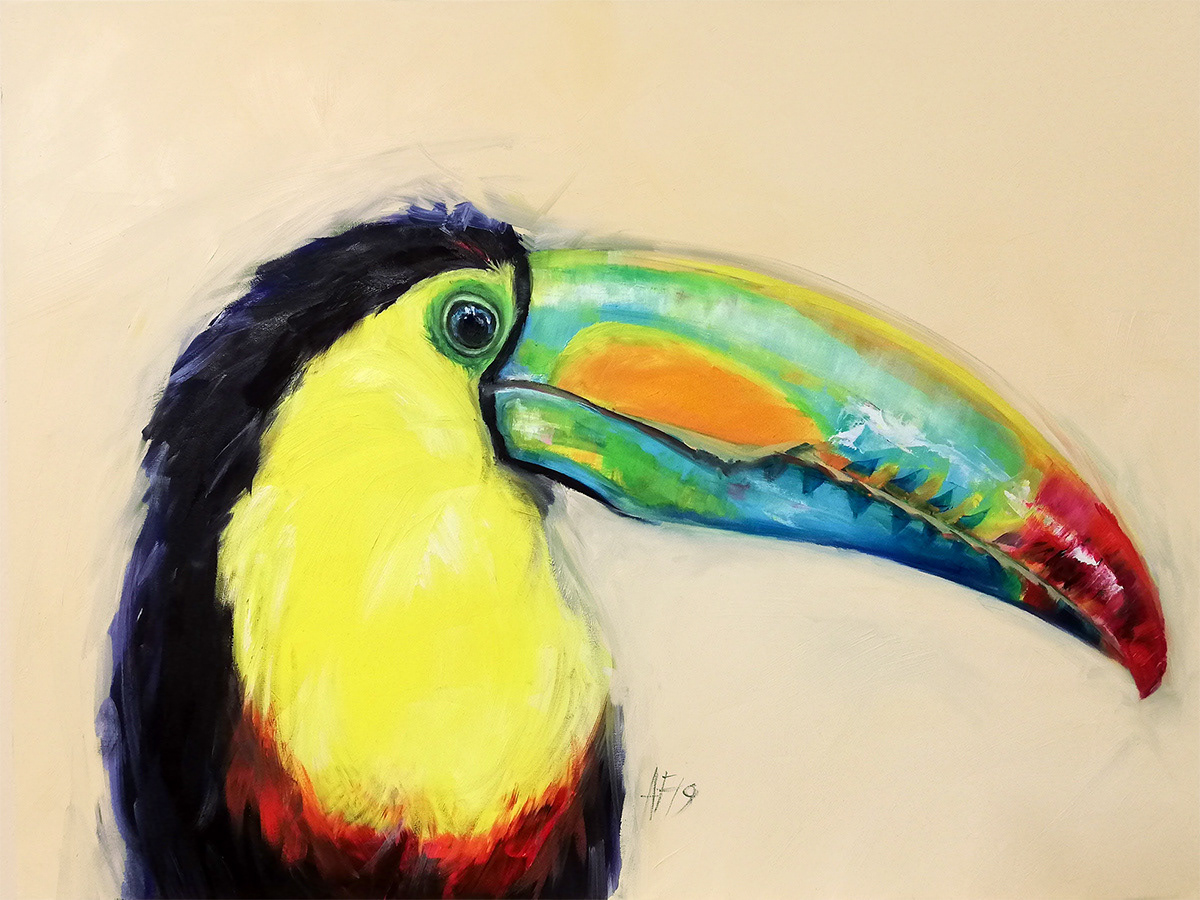
"Keel-billed toucan" - (Ramphastos Sulfuratus) is a species of toucans from the genus Ramphastos. Area: The rainbow toucan is found in tropical rainforests from southern Mexico to northern Colombia and northeastern Venezuela. It occurs up to a height of 1900 meters. Birds mainly feed on fruits, less often on insects, tree frogs, and in complete starvation even on chicks of other bird species. Rainbow toucans very rarely look for food on the ground, mostly they find it high in the crowns of trees.
. . . . . . . . . . . . .
Mimi Kraz - Mimi Kraz - "Temminck's tragopan" - illustrations are made with Adobe Photoshop and Wacom Intuos Pro tablet.
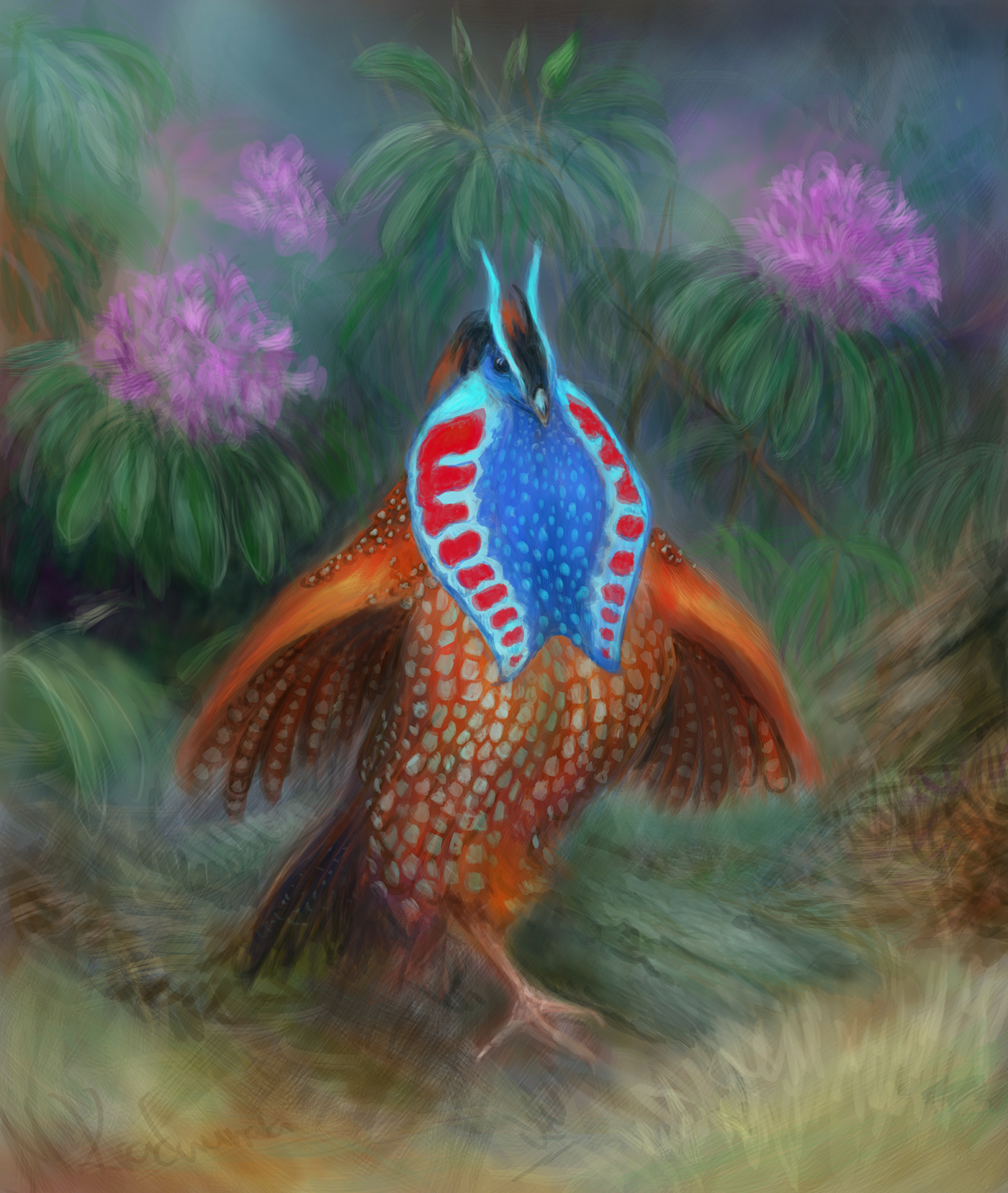
The Temminck's tragopan (Tragopan temminckii) is a medium-sized, approximately 64 cm long, pheasant in the genus Tragopan. Its appearance resembles the satyr tragopan, but unlike the latter species it has a all red upperbody plumage and an orange collar. The diet consists mainly of berries, grass and plants, is found across the mountains of far northeast India, central China, far northern Myanmar to northwestern Tonkin. Widespread and a common species throughout its large habitat range, the Temminck's tragopan is evaluated as Least Concern on the IUCN Red List of Threatened Species.
. . . . . . . . . . . . .
Terumi Arai - Terumi Arai - "Japanese grosbeak”. I used acrylic paint, cut paper, and Photoshop to create my artwork.
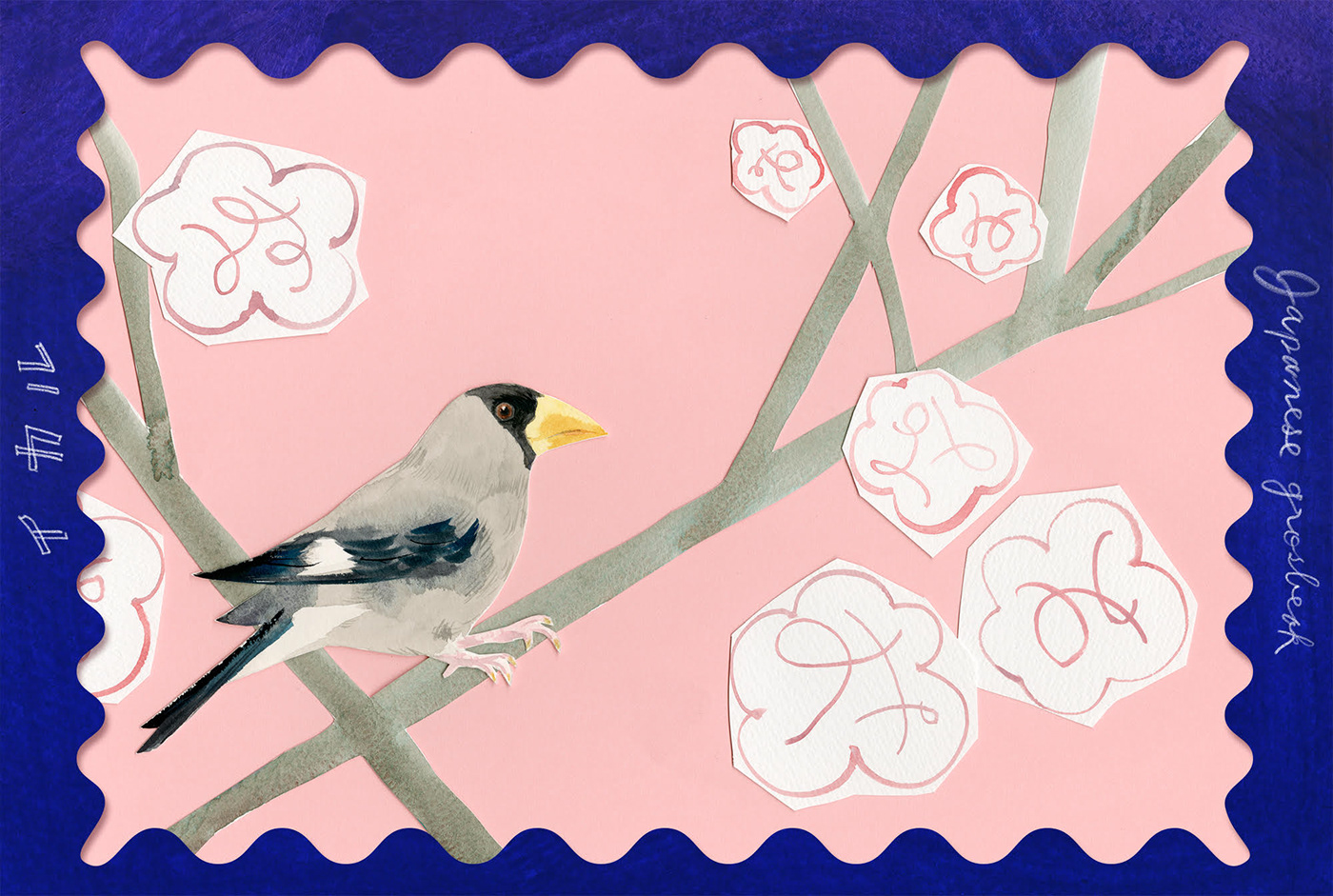
Japanese grosbeak (Eophona personata) or Ikaru is a finch that lives in the Eastern Palearctic. It is also sometimes referred to as Japanese hawthorn or disguised hawthorn due to its superficial resemblance to well-known Eurasian species. Wintering down in Hebei and Beijing, uncommonly ranging south towards North Korea. The nominate race occurs in Japan from Hokkaido to Kyushu and is not as seasonally migratory but does wander considerably during winter, largely in pursuit of food sources. The Japanese grosbeak is locally common, occasionally being abundant around prime feeding areas. It occurs in deciduous or mixed forests. More commonly, it is a bird of valleys rather than hillsides. This species also turns up in woods and groves of oak and birch and well-wooded parks and gardens. The species may winter on the edge of cultivated areas. The Japanese grosbeak usually occurs in pairs or small flocks. Behaviorally, it can be deceptively secretive, often staying hidden in foliage near the tree canopy. However, its location may regularly be betrayed by its voice.
. . . . . . . . . . . . .
Katya Sviridova Katya Sviridova "Mallard - wild duck" - bird in the technique of doodling and silhouette.

"Mallard - wild duck" - Partly migratory bird. Inhabits water and easily dissolves water. In recent years, many birds spend the winter on non-freezing waters in their cities and their environs. AreaMallard is widespread in the northern hemisphere. It breeds as in the Arctic latitudes to the north up to 70 ° C. w., and in a warm subtropical climate to the south to 35 ° C. w. in North Africa and up to 20 ° C. w. in the Middle East.
. . . . . . . . . . . . .
Kha.illust Art - Kha.illust Art - "White stork"
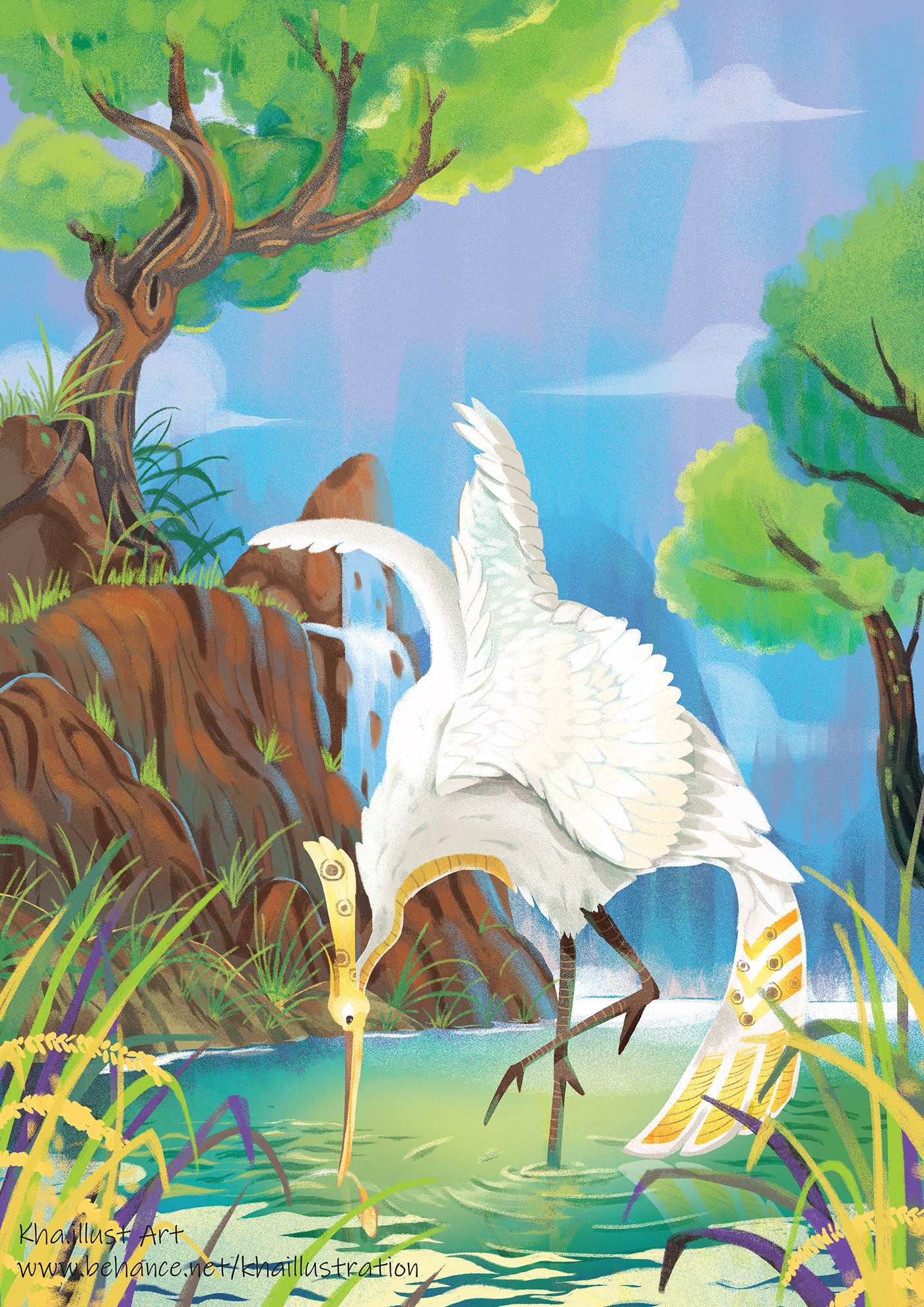
The white stork (Ciconia ciconia) is a large bird from the stork family Ciconiidae. Its plumage is mostly white, with black wings. Adults have long red legs and long, pointed red bills, and measure on average 100–115 cm (39–45 in) from bill tip to tail tip, with a wingspan of 155–215 cm (61–85 in). Two subspecies, which differ slightly in size, breed in Europe (north to Finland), northwest Africa, southwest Asia (east to southern Kazakhstan), and southern Africa. The white stork is a long-distance migrant wintering in Africa from tropical sub-Saharan Africa to as far south as South Africa or the Indian subcontinent. Migrating between Europe and Africa, it avoids crossing the Mediterranean and detours through the Levant in the east or the Strait of Gibraltar in the west because the air thermals on which it depends for soaring do not form over water.
. . . . . . . . . . . . .
Tina Kapri - Tina Kapri - "Oriental dwarf kingfisher" - Drawn with the mouse in Adobe Illustrator.





1. Bright colorful gradients and noise are used here. Adding noise is a common technique in vector illustrations. It is used to create volume or enhance vibration. In this work, I tried to create a bright image with a little vibration.
2. Lineart style. Pretty fashionable now style in illustration and graphic design. But I used this style with some deviations. In its purest form, the silhouette usually consists of just one line, swirling intricately into a certain image, and is often complemented by splashes of color in an abstract form.
3. I had a reference with an abstract picture, which was drawn according to the principle of dividing objects into color sectors. I just took this principle as a basis, and decided to try the same in my illustration. For me it was pure improvisation, but I really enjoyed working with this style. Maybe I will use it in my future work.
4.The fourth picture is drawn in a modern flat style. A monochrome palette is used here.
The eastern pygmy kingfisher (Ceyx erithaca), also known as the black-backed kingfisher or three-toed kingfisher, is a pocket bird in the Alcedinidae family. This tropical kingfisher is a partial migrant endemic to much of the Indian subcontinent and Southeast Asia. It lives in lowland forests, usually near streams or ponds, where it feeds on insects, spiders, worms, crabs, fish, frogs, and lizards. This small bird is easily distinguished from other birds in its range by its red bill, yellow-orange underparts, lilac-red upperparts, and blue-black back.
. . . . . . . . . . . . .
"Debaditya Patra - Debaditya Patra - 1."Hornbills" (Bucerotidae) 2. "Blue jay" 3. "Columba - Columbidae" (bird) 4. Schalow's turaco - (Tauraco) 5. "Keel-billed toucan" 6. "House sparrow" 7. "Hummingbird" 8. "Scarlet macaw" (Ara macao) 9. "Kiwi" (bird) - graphics in pencil.
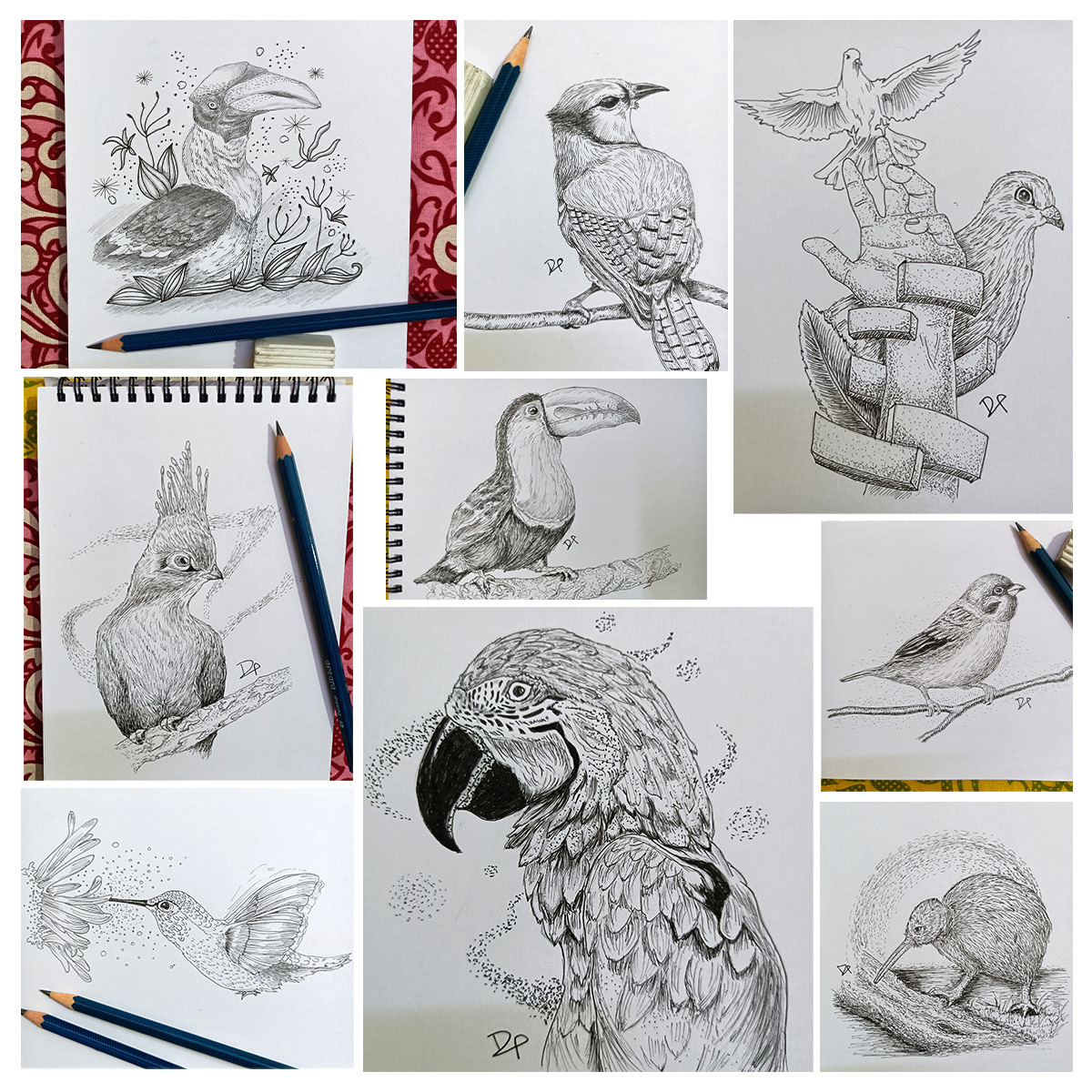
The blue jay (Cyanocitta cristata) is a passerine bird in the family Corvidae, native to eastern North America. It lives in most of the eastern and central United States; some eastern populations may be migratory.
Columbidae is a bird family consisting of doves and pigeons. It is the only family in the order Columbiformes. These are stout-bodied birds with short necks and short slender bills that in some species feature fleshy ceres. They primarily feed on seeds, fruits, and plants. The family occurs worldwide, but the greatest variety is in the Indomalayan and Australasian realms.
Schalow's turaco (Tauraco schalowi) is a frugivorous bird in the family Musophagidae. This bird's common name and Latin binomial commemorate the German banker and amateur ornithologist Herman Schalow.
Hummingbird are birds native to the Americas and constitute the biological family Trochilidae. Numbering about 361 species and 113 genera, they are found from Alaska to Tierra del Fuego, but the vast majority of species live in the tropics around the equator.
The scarlet macaw (Ara macao) is a large red, yellow, and blue Central and South American parrot, a member of a large group of Neotropical parrots called macaws. In some areas, it has suffered local extinction because of habitat destruction, or capture for the parrot trade, but in other areas, it remains fairly common. It is the national bird of Honduras. Like its relative the blue-and-yellow macaw, the scarlet macaw is a popular bird in aviculture as a result of its striking plumage.
Kiwi (bird) - are flightless birds endemic to New Zealand of the order Apterygiformes. The five extant species fall into the family Apterygidae and genus Apteryx Approximately the size of a domestic chicken, kiwi are by far the smallest living ratites (which also include ostriches, emus, rheas and cassowaries).
. . . . . . . . . . . . .
Victoria Rice Victoria Rice - "Redwing"
Аrtistic graphic technique with colored pencils
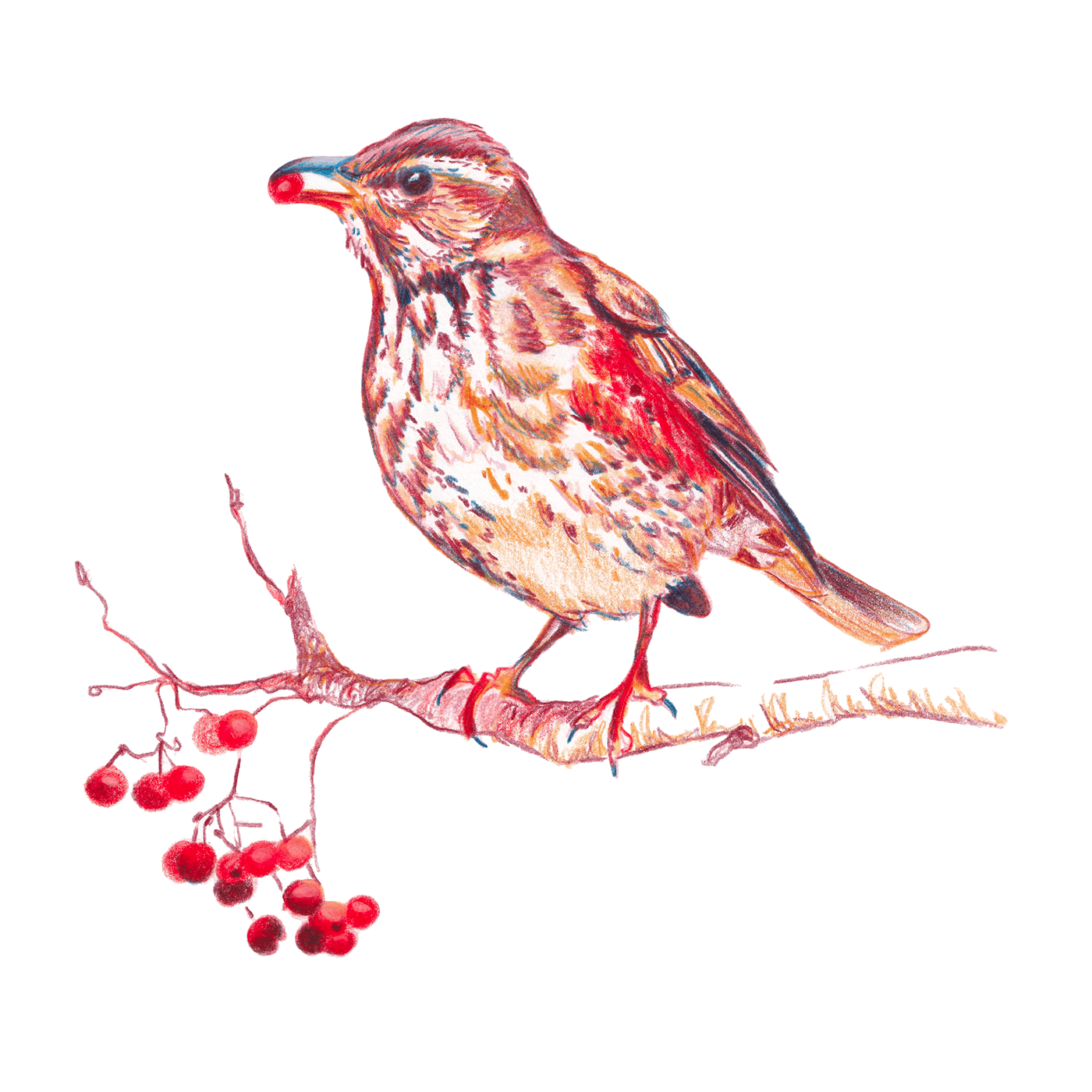
"Redwing" - a bird of the thrush family, common in Europe and Asia. It nests in forests of various types, but especially willingly in mixed, coniferous-deciduous forests. Among deciduous trees, it prefers alder, sometimes birch and beech trees; among conifers - spruce-alder, spruce-birch and spruce-broad-leaved forests. It settles in areas with undergrowth and undergrowth, with brushwood and piles of brush, does not avoid young forests and overgrown clearings with groups of spruce trees, as well as thickets of bushes near the forest. Willingly settles in wet places, as well as near water and in floodplains. It also permeates the cultural landscape — it can be found in city parks and squares.
. . . . . . . . . . . . .
Drawing technique - graphics in pencil.
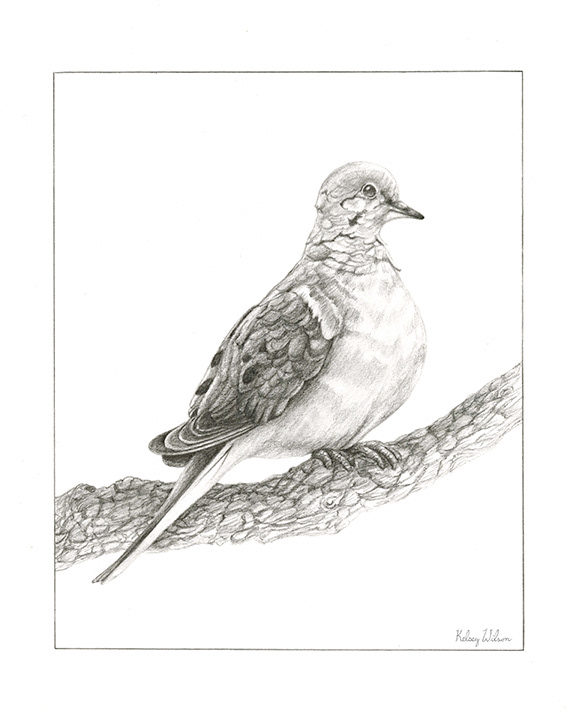
"Mourning dove" - order of pigeon-like birds, pigeon family. Distributed in North America from Canada and California to Mexico. A bird 30 cm long. It is an object of sport hunting, however, there are a number of organizations in the USA that advocate for a ban on shooting this species of birds.
. . . . . . . . . . . . .
Katya Sviridova Katya Sviridova "Great hornbill" - bird in the background in the technique of dudling.
Dudling (from the English doodle - “scribble”) is an unconscious drawing made during some kind of lesson. Those same flowers, lines and little men, which we involuntarily sometimes display on a piece of paper. For this kind of drawings, the term “griffonage” is also used.
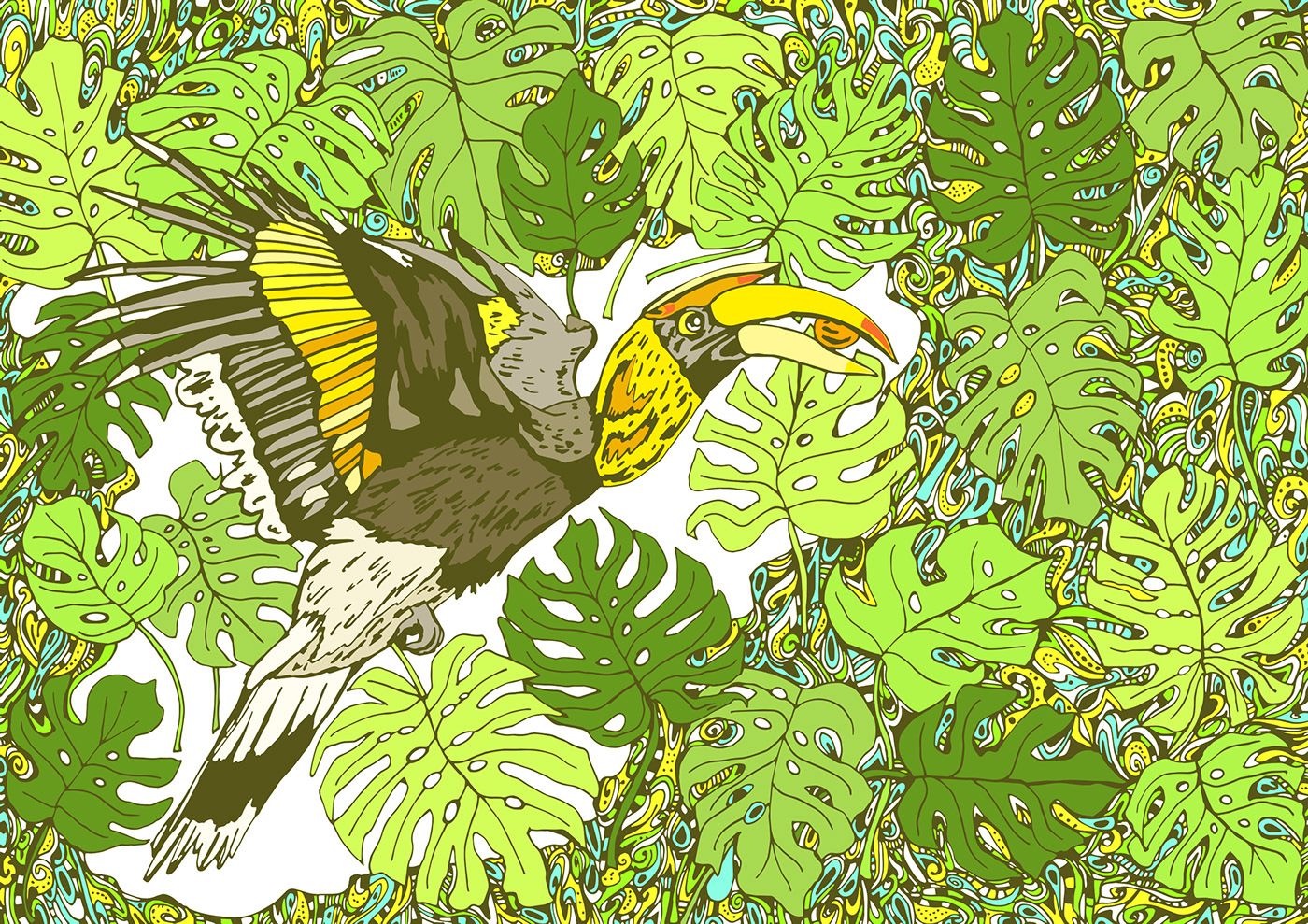
Great hornbill - the largest bird of the genus of two-horned hornbills of the hornbill family, whose body length reaches 1.5 m. In captivity, a two-horned hornbill can live up to fifty years. The range of kalao extends from Western India east to Thailand and south through the Malay Peninsula to the island of Sumatra inclusive. They live in the crowns of tropical jungle trees. The favorite places of these birds are the tops of evergreen trees, where they find enough food all year round. The protection status is a vulnerable species.
. . . . . . . . . . . . .
Debaditya Patra - Debaditya Patra - "Flamingo" - Adobe Illustrator
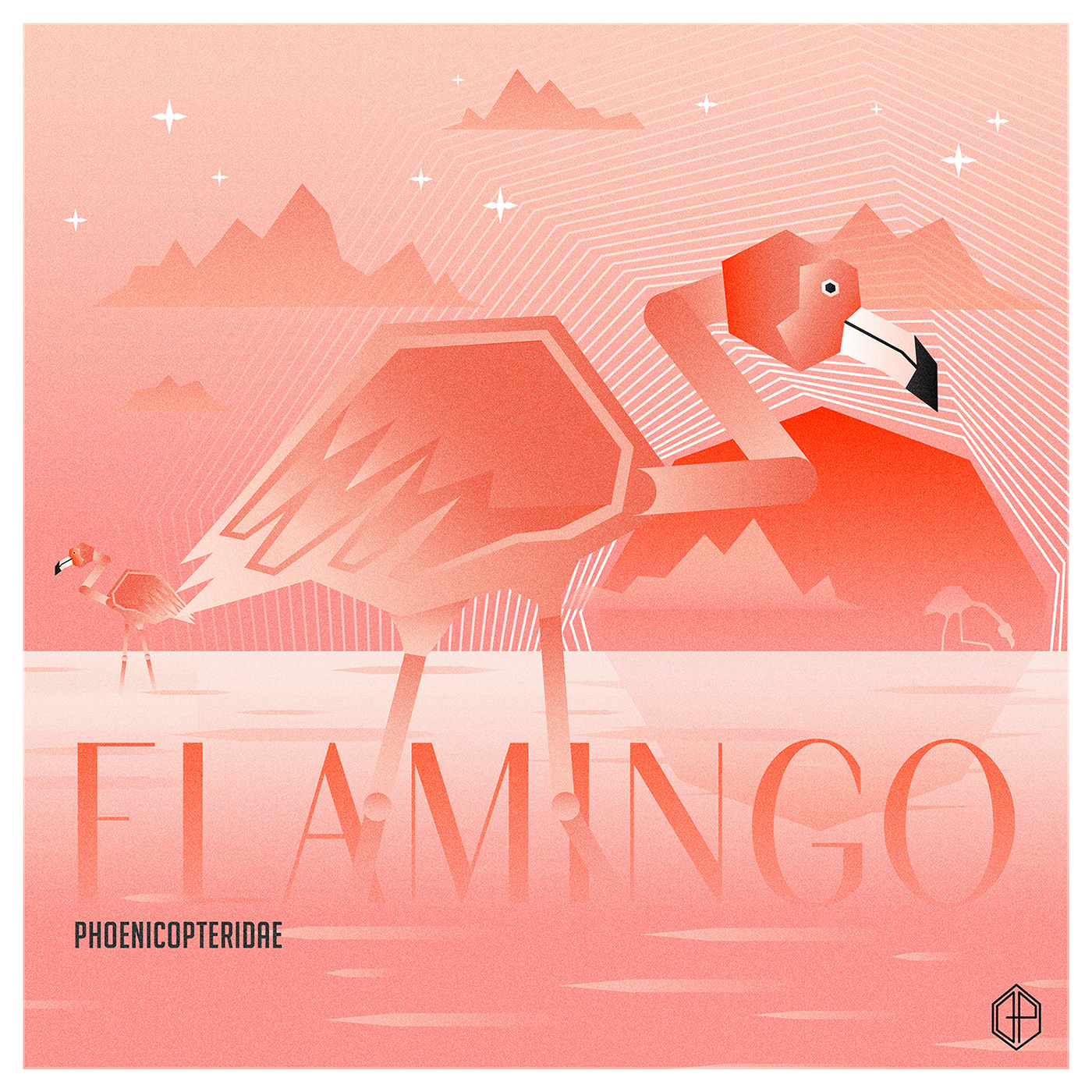
Flamingo - (Phoenicopterus) is a genus of waterfowl of the flamingo family (Phoenicopteridae). Contains three types. The genus is distributed in the south of South America, in Central America, Africa, Southern Europe and tropical Asia. Species
Six extant flamingo species are recognized by most sources, and were formerly placed in one genus (have common characteristics) – Phoenicopterus. As a result of a 2014 publication, the family was reclassified into two genera. In 2020, the family had three recognized genera, according to HBW. Species:
Chilean flamingo (Phoenicopterus chilensis)
Pink flamingo (Phoenicopterus roseus)
Red flamingo (Phoenicopterus ruber)
Six extant flamingo species are recognized by most sources, and were formerly placed in one genus (have common characteristics) – Phoenicopterus. As a result of a 2014 publication, the family was reclassified into two genera. In 2020, the family had three recognized genera, according to HBW. Species:
Chilean flamingo (Phoenicopterus chilensis)
Pink flamingo (Phoenicopterus roseus)
Red flamingo (Phoenicopterus ruber)
. . . . . . . . . . . . .
chiaki suzuki - chiaki suzuki "Motacilla samveasnae" - Material - watercolor
Title: A tiny postman - "whenever i see this bird always walking at high speed here and there, i think it would be lovely if such tiny postman delivers letters to us. that brought me an idea to make this illustration."
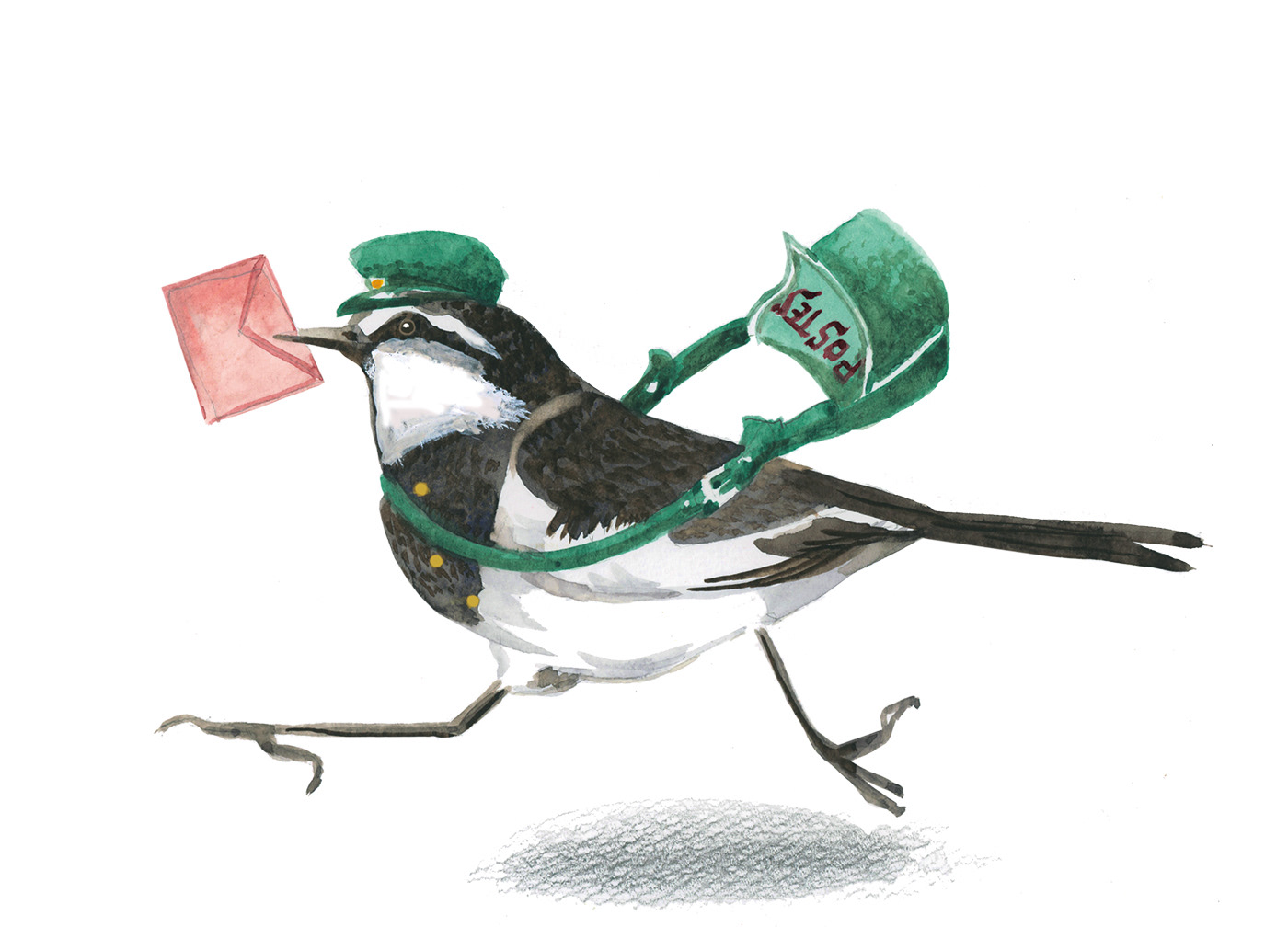
"Motacilla samveasnae" - is a species of bird in the family Motacillidae. The Mekong Wagtail is found in the Mekong Valley in Cambodia and Laos, and does not breed in Thailand and Vietnam. The typical habitat is rocky areas next to fast-flowing sections of the river where seasonal flooding occurs. Although it is tolerant of humans, it is threatened by large-scale changes to its habitat, such as flooding of a riverine habitat after damming a river.
. . . . . . . . . . . . .
Mayuco Abe - Mayuco Abe - "Brambling" - Сopper engraving, etching.
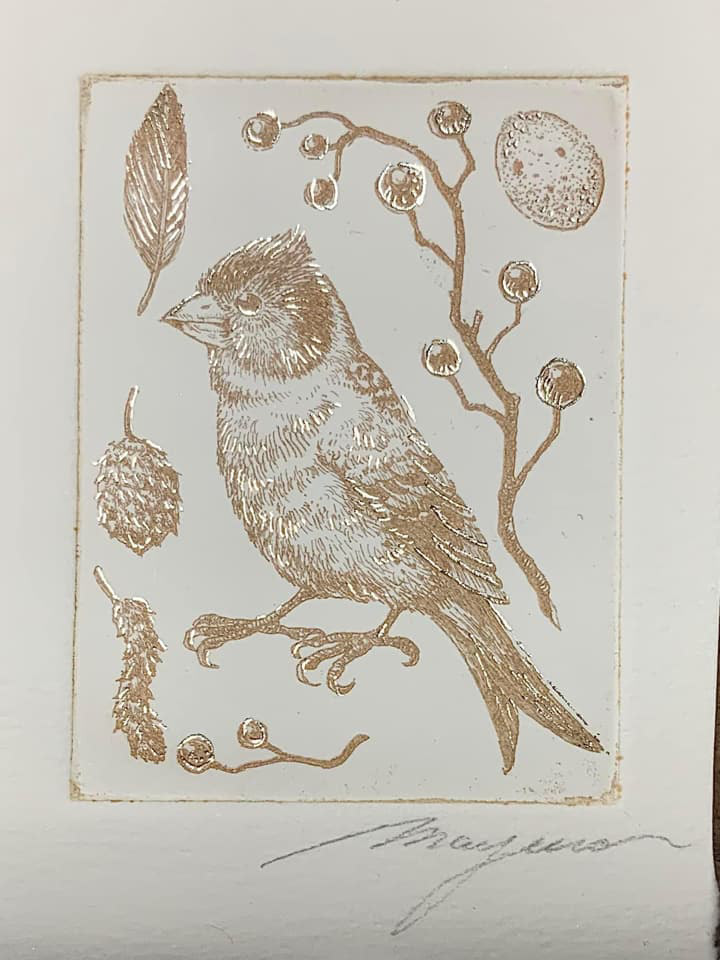
Yurok (Fringilla montifringilla) is a small passerine bird of the finches family Fringillidae. It was also called the northern rooster and the mountain finch. It is widely distributed and migratory, often found in very large flocks. This bird is widespread during the breeding season in the forests of northern Europe and in the east of the Palearctic. Migratory, winters in southern Europe, northern Africa, northern India, northern Pakistan, China and Japan. It frequently wanders into Alaska on its migration, and there are scattered records in the northern United States and southern Canada. The world population of bramblings ranges from 100 to 200 million individuals with a declining trend.
Open coniferous or birch forests are favorable for breeding.
Open coniferous or birch forests are favorable for breeding.
. . . . . . . . . . . . .
Katya Sviridova Katya Sviridova "Taiwan blue magpie" - bird in the background in the technique of dudling
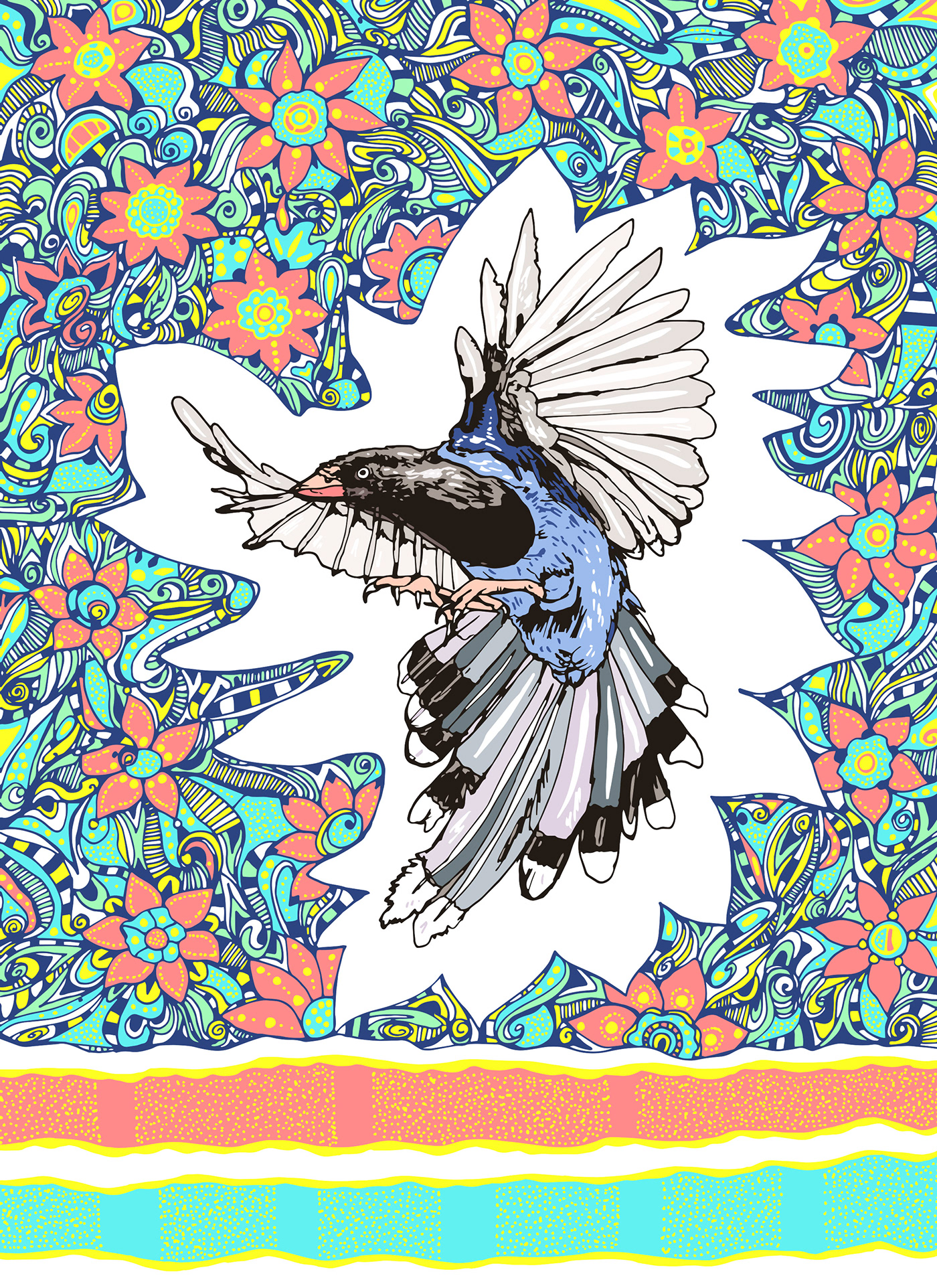
"Taiwan blue magpie" - one of the species of azure magpies from the corvidae family. Habitat Taiwan, Birds live in mountainous areas at an altitude of 300 to 1200 meters. Body length - up to 65 cm, tail - about 40 cm, wing length - 18-21 cm. The body and tail have a dark blue color, often turning into purple, there are white marks. The legs and beak are red, the plumage of the neck, chest and head is black. The rims around the eyes are yellow. Their diet includes small snakes, rodents, insects, figs, seeds, and do not disdain fallen animals.
. . . . . . . . . . . . .
Victoria Rice Victoria Rice - "Stonechat"
Аrtistic graphic technique with colored pencils

"Stonechat" - a small insectivorous sparrow-like bird, the black-headed stonechat feeds on insects, spiders and worms, which it catches more often on the ground. Distribution - the stonechat lives in open areas with rare bushes, for example, in upland swamps and wastelands. The wintering region is the south and west of Europe. The nest is built entirely by the female. It has the form of a loose non-woven bowl. The nest is well camouflaged, built from grass, stalks, moss and roots in a depression in the ground.
. . . . . . . . . . . . .
Katya Sviridova Katya Sviridova - "Great bustard" the technique of drawing a graph with a liner.

"Great bustard" - a large bird of the woodpecker family (Otididae), the only representative of its kind. It breeds in Central and Southern Europe, where it is the largest bird species, and in most of temperate Asia. European populations are usually sedentary, while Asian populations migrate south in winter. It is one of the largest birds of Ukraine. The bird flies perfectly, it prefers to move on the ground, even in case of danger it tries to escape first, developing at the same time a fairly high speed. She flies, slowly flapping her wings. The cry of a woodpecker is a quiet crackling that can be heard only up close. feeds on plant food - grains and other plant seeds, eats vegetables, except for potatoes, especially likes peas, cabbage and mustard, pinches young grass. It can also catch small mammals, amphibians and some invertebrates, including insects. In the spring, they feast on their larvae and eggs. The number is decreasing due to the overgrowth of deer and pastures; reduction of watering places; destruction of nests during livestock grazing, hay cutting and fallow cultivation; scaring away birds, increasing the number of wild dogs and crows; removal from nature of clutches and broods.
. . . . . . . . . . . . .
Annalisa Faglioni Annalisa Faglioni - "Secretarybird"
Acrylic on canvas - 50x70 cm.
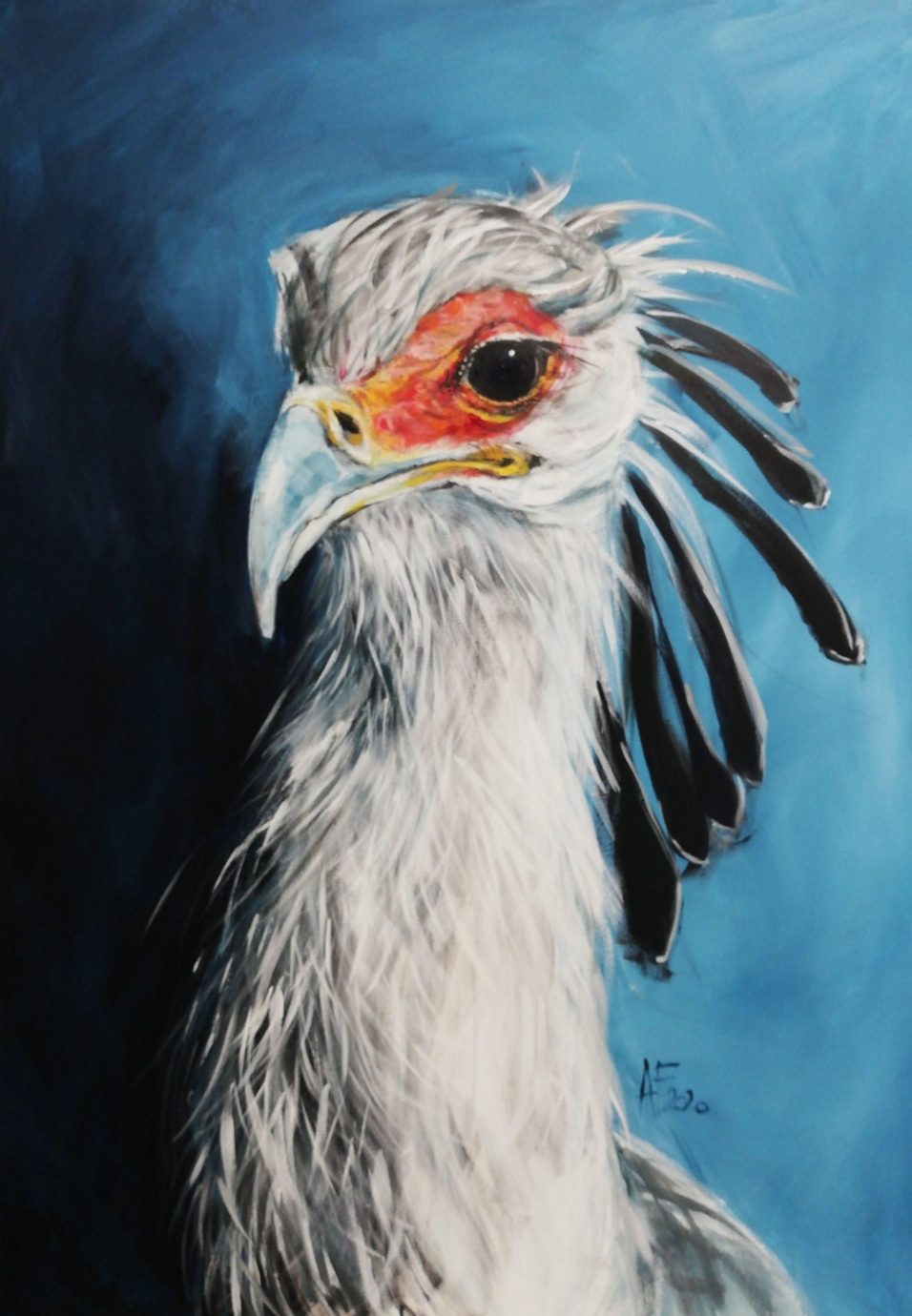
"Secretarybird" - Species of birds from the hawk-like order, in the family of unique secretary birds (Sagittariidae). Her peculiar name comes from the black goose feather feathers on her head that court clerks used to wear in their wigs. Unlike other birds of prey that hunt from the air, secretaries spend most of their time on the ground, on which they can move relatively quickly. The secretaries lead a wandering life. They travel from place to place in search of food. At the same time, both partners, who, as a rule, remain faithful to each other for life, remain close and move away from each other only within the radius of vision. First of all, they can be found in savannahs and rare places. Near human settlements, their populations are usually small, since many nests are ruined.
. . . . . . . . . . . . .
Katya Sviridova Katya Sviridova - "Eurasian eagle-owl" the technique of drawing a graph with a liner.
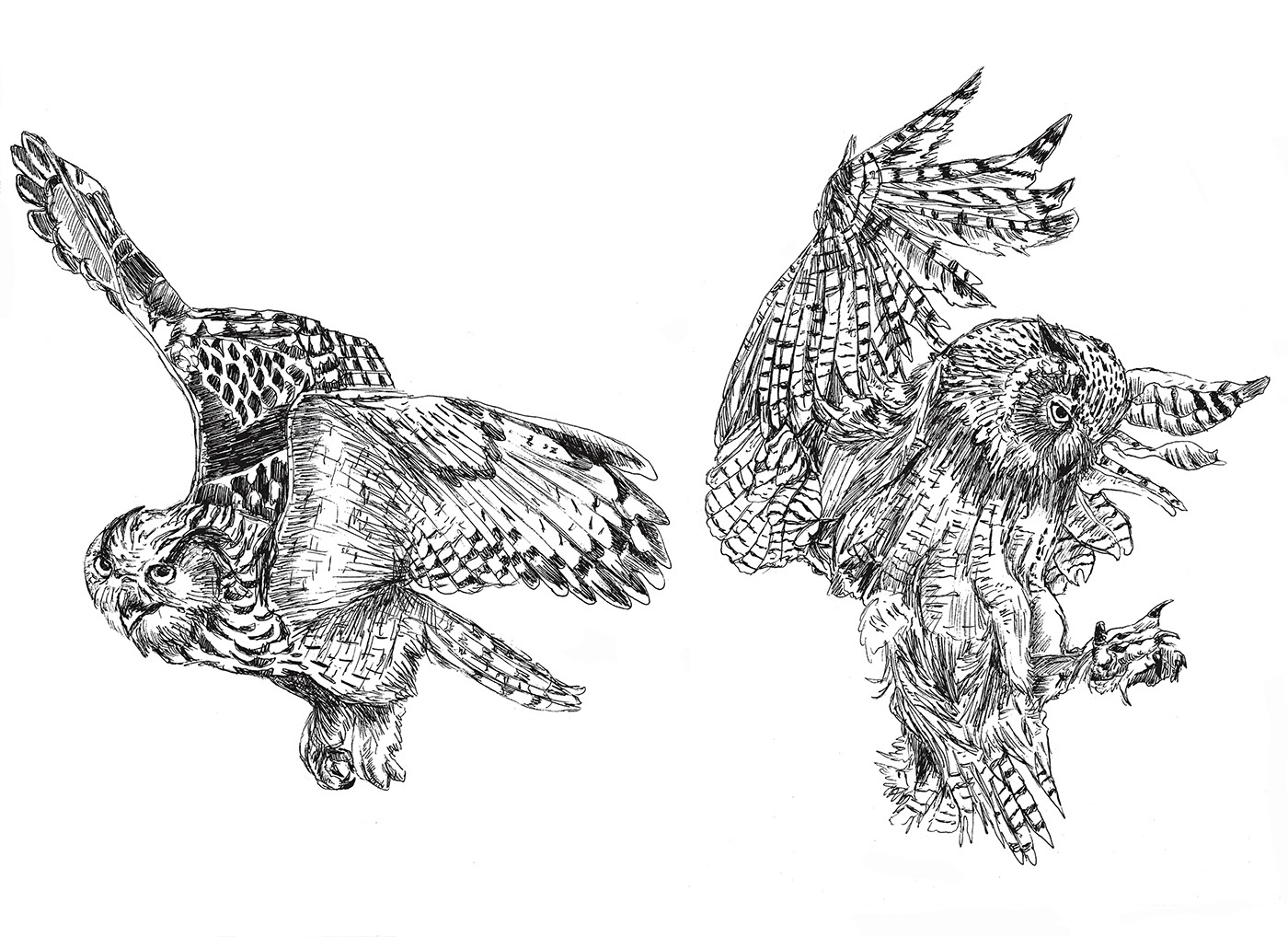
"Eurasian eagle-owl" - Active at dusk and at night. Turning takes place at the end of winter. It nests in deep ravines, coastal cliffs, rock outcrops, rarely in forests and swamps. Eggs are laid in late February - early March. Nests are arranged in remote areas of forests, ravines or rock outcrops on the ground in niches, on ledges or under the roots of trees and shrubs.
. . . . . . . . . . . . .
Annalisa Faglioni Annalisa Faglioni "Philippine eagle"
Acrylic on canvas 70x50 cm
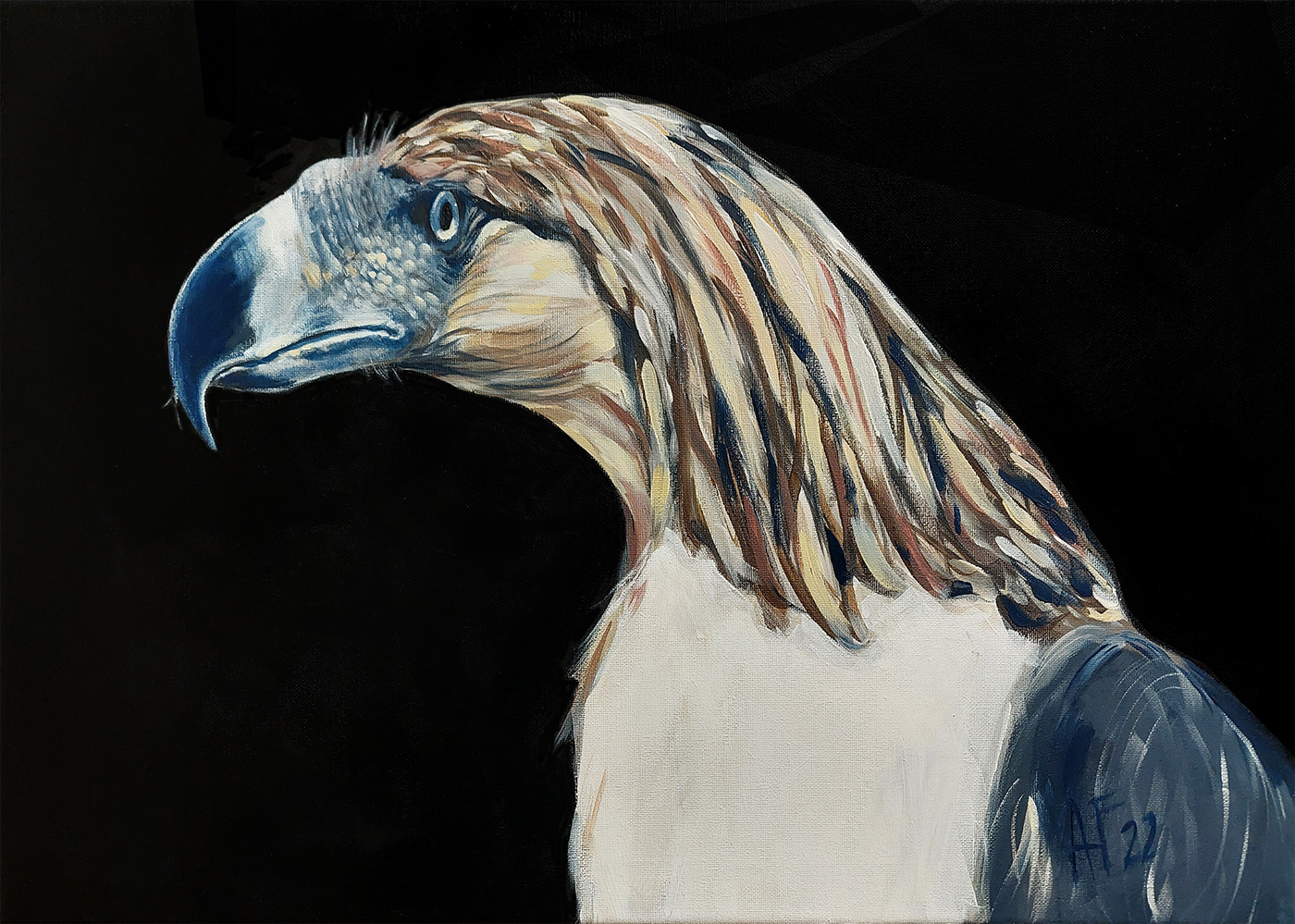
"Philippine eagle" - bird of prey from the hawk family. One of the rarest, largest and strongest birds in the world. It lives exclusively in the tropical forests of the Philippines and is one of the national symbols of this country. Killing this endangered bird is punishable under Philippine law by twelve years in prison and a heavy fine. lives in dense, tall tropical forests. Due to the destruction of living space, the population has now been reduced to 200-400 individuals. The species is critically endangered.
. . . . . . . . . . . . .
Katya Sviridova Katya Sviridova "Great grey owl" the technique of drawing a graph with a liner.
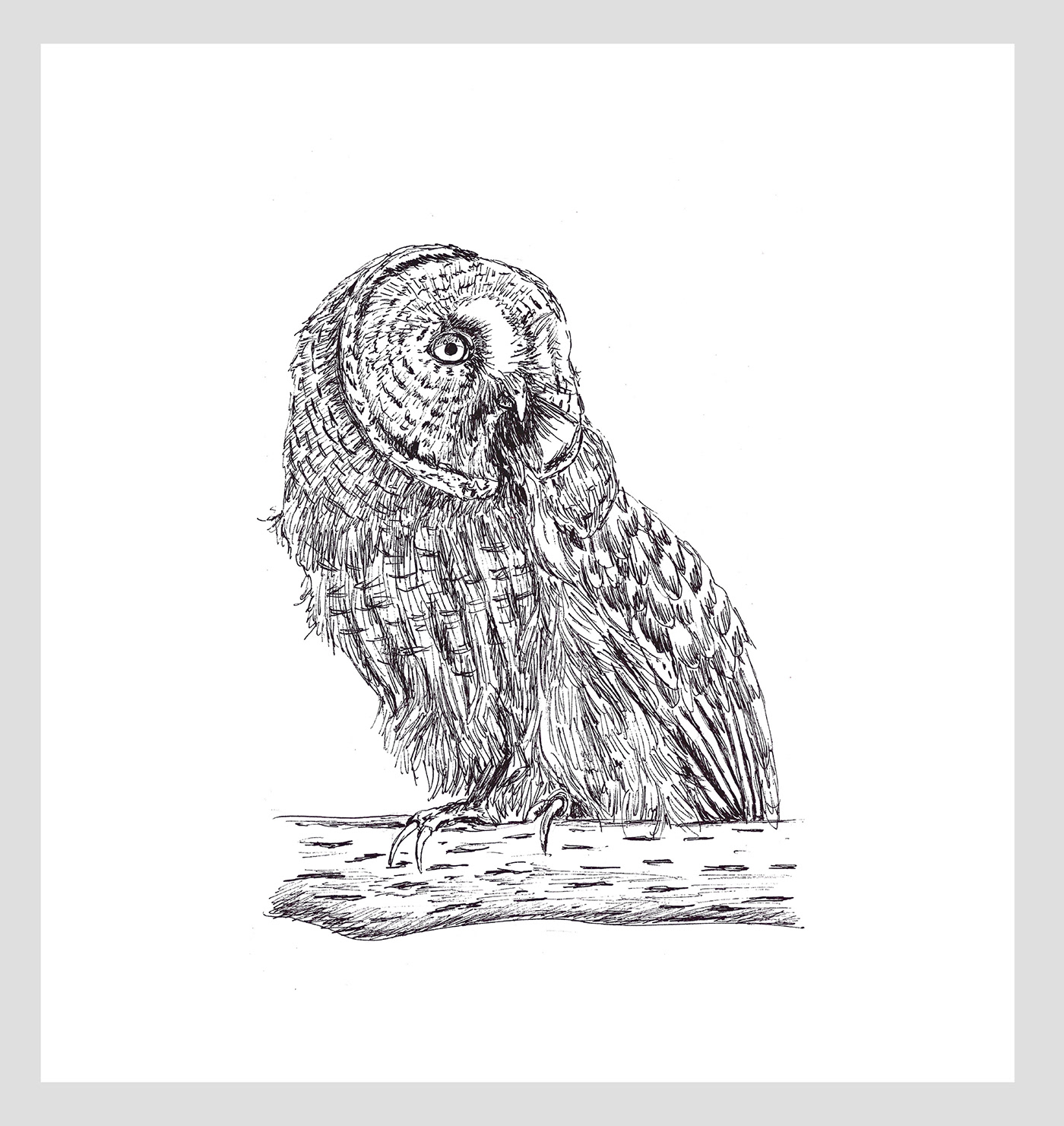
"Great grey owl" - a bird of the Owl family (Strigidae) of the Strigiformes series. The range covers North America from Central Alaska eastward to Western Quebec. In Eurasia — to the north to 52° N. latitude from Scandinavia to the east to the Anadyr basin, the coast of the Sea of Okhotsk and the Sea of Japan. Makes only small migrations. Prefers old mixed and coniferous forests, areas near forest clearings and wetlands. Nesting begins at the end of March - beginning of April. Occupies the nests of other large birds located in trees, also nests in semi-hollows, sometimes on high stumps with a rotten core.
. . . . . . . . . . . . .
Katya Sviridova Katya Sviridova "Boreal owl" - the technique of drawing a graph with a liner.
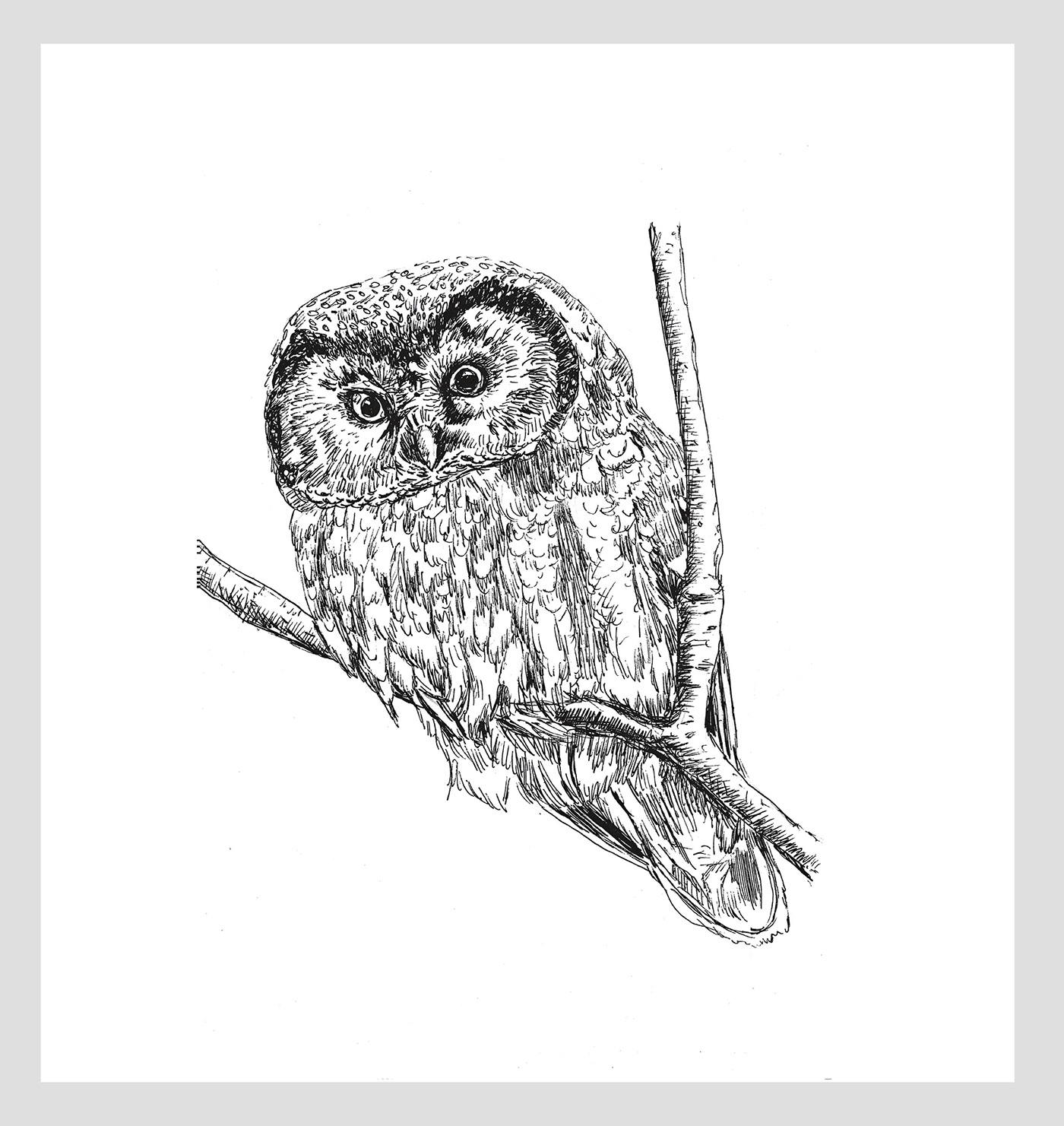
"Boreal owl" - a species of birds of the Strigidae family of the Strigiformes family. A rare nesting species in Ukraine. The European population is estimated at approximately 110,000-350,000 pairs. Widespread in the zone of coniferous and mixed forests of Eurasia and North America, it inhabits mature pine forests mixed with aspen and birch. It nests in hollows of the black spruce, occupies artificial nests. It feeds on mouse-like rodents, less often birds, large insects.
. . . . . . . . . . . . .
Annalisa Faglioni Annalisa Faglioni "Barred eagle-owl"
Pencils on paper

"Barred eagle-owl" - Species of birds of the genus owl, living in Southeast Asia. The scientific name sumatranus was given in honor of the island of Sumatra, where it was first described. The natural habitat is subtropical or tropical moist forests. It prefers evergreen forests with pools or streams, but is also found in large gardens with tall, densely devoid of trees, such as the Bogor Botanical Gardens found in West Java, and also in wooded groves in cultivation, both sometimes not far from human habitation. It usually varies from about 1,000 m to 1,600 m above sea level.
. . . . . . . . . . . . .
2. Birds and retro things.
DIGITAL NIBS - DIGITAL NIBS - "Southern cassowary"

"Southern cassowary"- reaches a height of 1.5 m and a weight of about 80 kg. It has a hard black plumage, a long neck, massive legs; red beards (up to 17 cm long) hang around the throat. On the head, the cassowary has an outgrowth called a "helmet", which is larger in males than in females. The color of the hanging folds of skin on the neck, or earrings, can vary depending on the mood of the cassowary.
. . . . . . . . . . . . .
Debaditya Patra - Debaditya Patra - "Victoria crowned pigeon" - Adobe Illustrator

Victoria crowned pigeon - (Goura victoria) is a large, bluish-grey pigeon with elegant blue lace-like crests, maroon breast and red irises. It is part of a genus (Goura) of four unique, very large, ground-dwelling pigeons native to the New Guinea region. The bird may be easily recognized by the unique white tips on its crests and by its deep 'whooping' sounds made while calling. Its name commemorates the British monarch Queen Victoria.
. . . . . . . . . . . . .
3. Birds and humans.
Debaditya Patra - Debaditya Patra - "Red-and-green macaw" - Adobe Illustrator
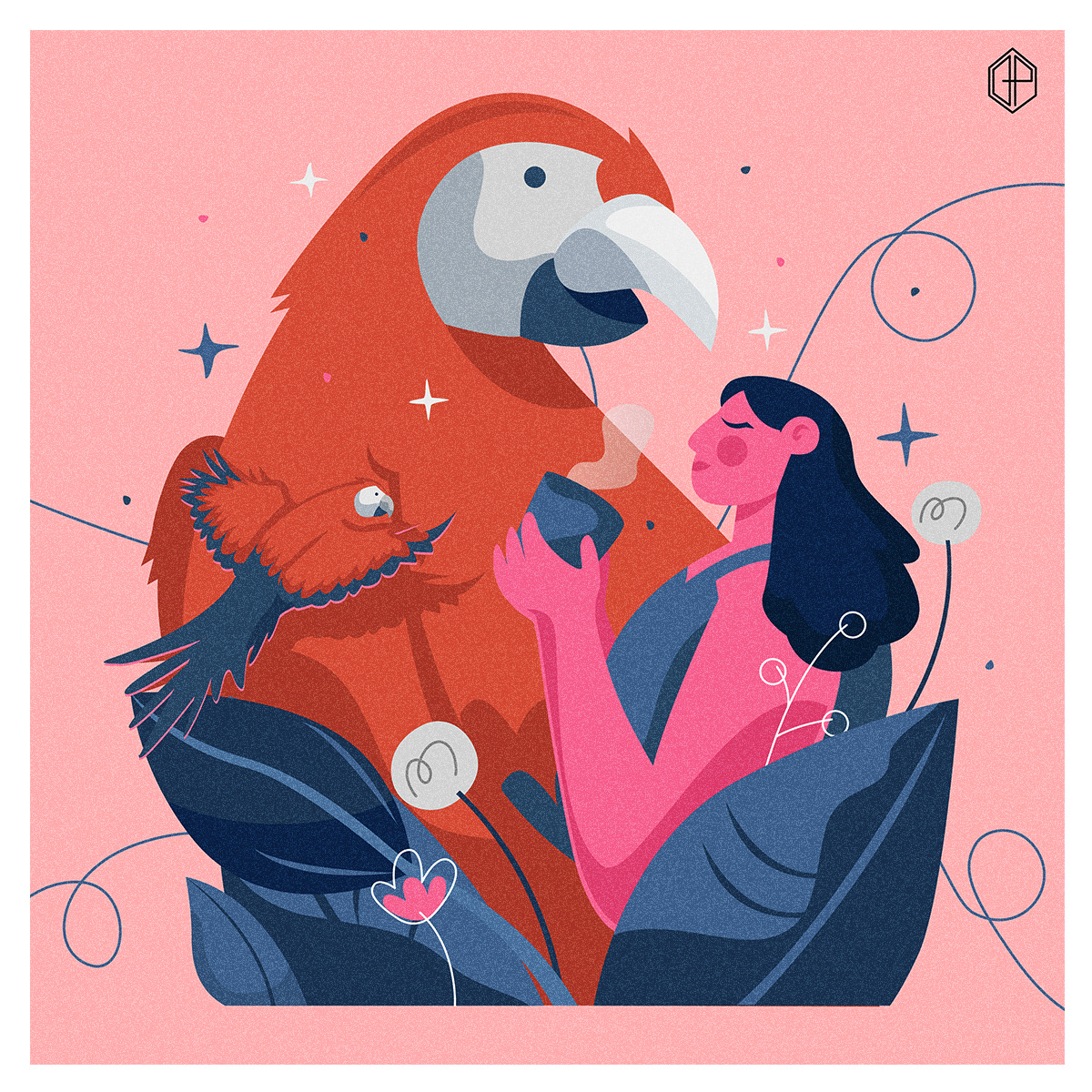
Red-and-green macaw - (Ara chloropterus), also known as the green-winged macaw, is a large, mostly-red macaw of the genus Ara. This is the largest of the genus Ara, widespread in the forests and woodlands of northern and central South America. However, in common with other macaws, in recent years there has been a marked decline in its numbers due to habitat loss and illegal capture for the parrot.
. . . . . . . . . . . . .
DIGITAL NIBS - DIGITAL NIBS - "European goldfinch"
Title of Artwork - a moment of relaxation European goldfinch

"European goldfinch" - Songbird of the finches family of the passerine order. Distributed in Europe, North Africa, Western Asia and Western Siberia. They inhabit clearings, gardens and deciduous groves, alternating with open spaces.
. . . . . . . . . . . . .
Debaditya Patra - Debaditya Patra - "Great tit" - Adobe Photoshop

Great tit - (Parus major) is a passerine bird in the tit family Paridae. It is a widespread and common species throughout Europe, the Middle East, Central Asia and east across the Palearctic to the Amur River, south to parts of North Africa where it is generally resident in any sort of woodland; most great tits do not migrate except in extremely harsh winters. Until 2005 this species was lumped with numerous other subspecies. DNA studies have shown these other subspecies to be distinct from the great tit and these have now been separated as two distinct species, the cinereous tit (Parus cinereus) of southern Asia, and the Japanese tit (Parus minor) of East Asia. The great tit remains the most widespread species in the genus Parus.
. . . . . . . . . . . . .
DIGITAL NIBS - DIGITAL NIBS - "Heliodoxa Jacula"
Title of Artwork - witchcraft Heliodoxa Jacula

"Heliodoxa Jacula"- it is a large, sturdy hummingbird that breeds regularly in the highlands from Costa Rica to western Ecuador. It is also known as the green-fronted diamond. This hummingbird feeds at the large inflorescences of Marcgravia vines, which the male will sometimes defend. It will also feed at Heliconia and other large flowers. Unlike many hummingbirds, the green-crowned brilliant almost always perches to feed.
. . . . . . . . . . . . .
Debaditya Patra - Debaditya Patra - "house sparrow (Passer domesticus)" - Adobe Illustrator

The house sparrow (Passer domesticus) is a bird of the sparrow family Passeridae, found in most parts of the world. It is a small bird that has a typical length of 16 cm (6.3 in) and a mass of 24–39.5 g (0.85–1.39 oz). Females and young birds are coloured pale brown and grey, and males have brighter black, white, and brown markings. One of about 25 species in the genus Passer, the house sparrow is native to most of Europe, the Mediterranean Basin, and a large part of Asia. Its intentional or accidental introductions to many regions, including parts of Australasia, Africa, and the Americas, make it the most widely distributed wild bird.
. . . . . . . . . . . . .
DIGITAL NIBS - DIGITAL NIBS - "Pink-eared duck"
Title of Artwork - My pride Pink-eared duck
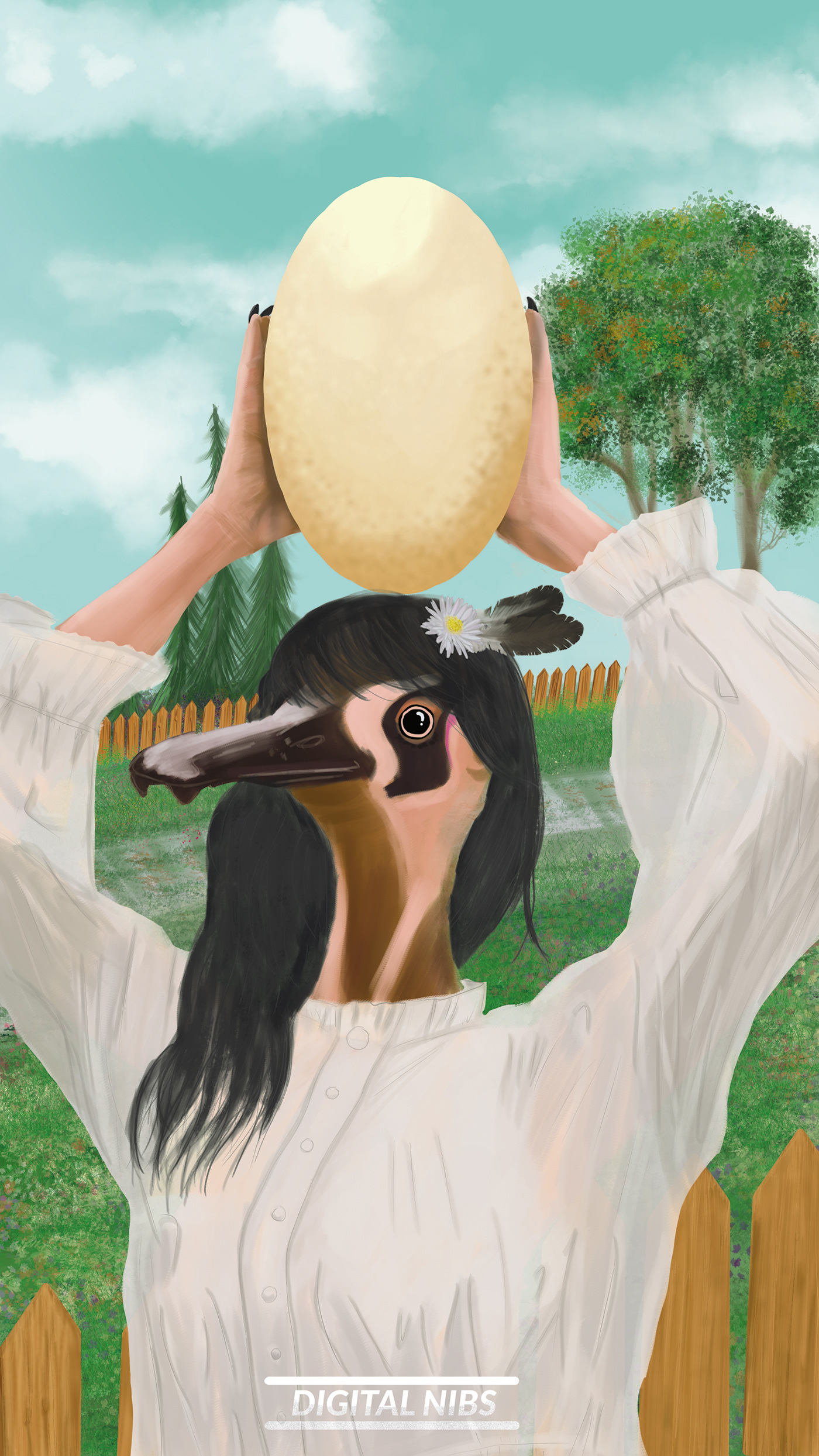
"Pink-eared duck" - Species of waterfowl of the family Anatidae. Distribution - This species of duck was found in Australia and due to its high mobility, these ducks can appear anywhere there is water, especially in humid inland areas where the annual rainfall exceeds 15 inches.
. . . . . . . . . . . . .
Katya Sviridova Katya Sviridova - "Plain-pouched hornbill"
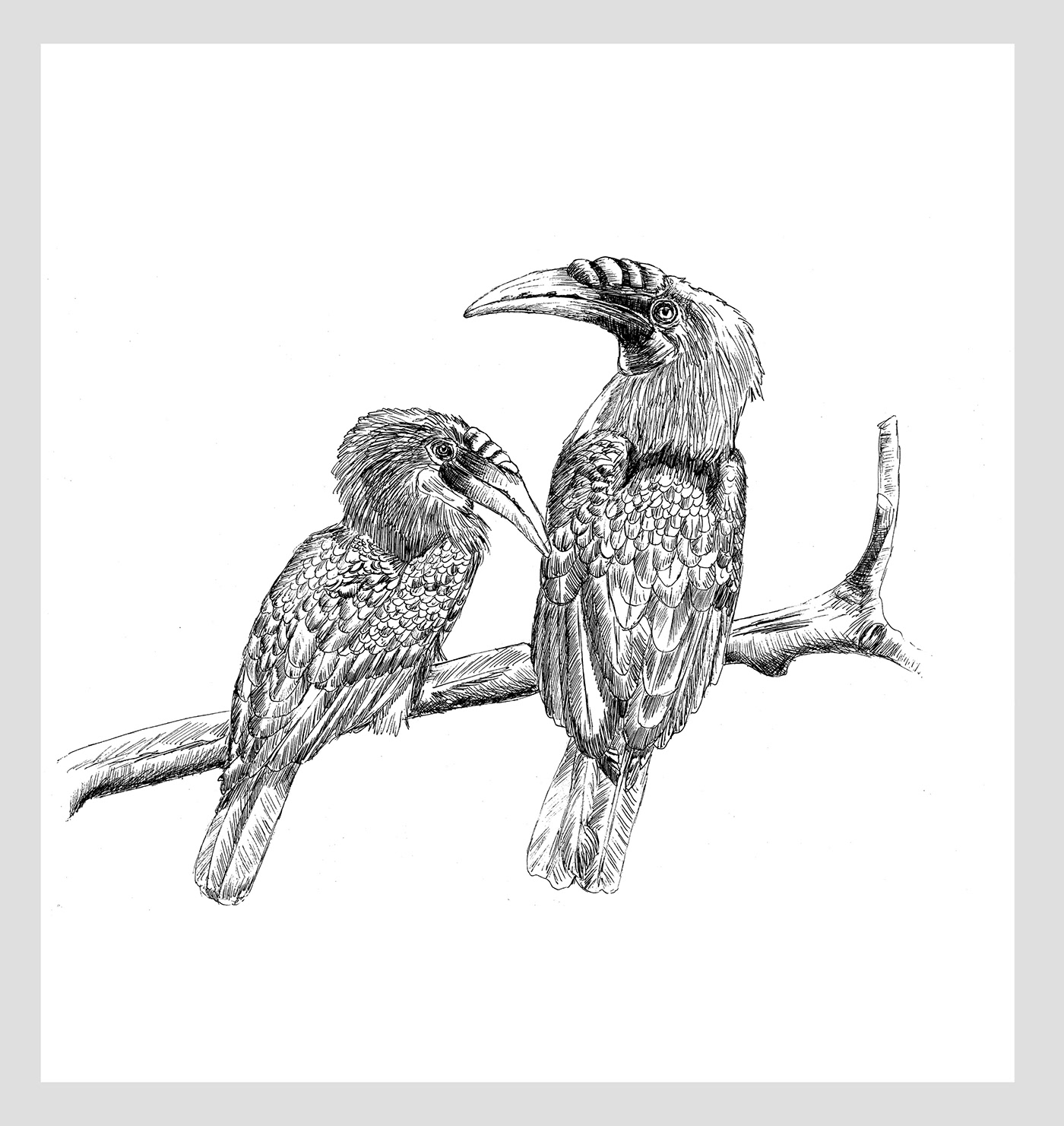
Plain-pouched hornbill - (Rhyticeros subruficollis) is a species of hornbill in the family Bucerotidae. It is found in forests of the Dawna Range and the Tenasserim Hills of southern Myanmar, adjacent parts of western Thailand and northern Peninsular Malaysia. It is threatened by habitat loss.
. . . . . . . . . . . . .
4. Ancient fossil birds.
Chandrasen M. Salvi - Chandrasen M. Salvi "Pterosaur"
Title of Artwork - Flying Dinosaur in Cyberspace

"Pterosaur" - were flying reptiles of the extinct clade or order Pterosauria. They existed during most of the Mesozoic: from the late Triassic to the end of the Cretaceous (228 to 66 million years ago). Pterosaurs are the earliest vertebrates known to have evolved powered flight. Like dinosaurs and unlike other reptiles, pterosaurs are more closely related to birds than they are to crocodiles or any other living reptile.
. . . . . . . . . . . . .
Viktória Kováts - Viktória Kováts - "Argentavis magnificens"
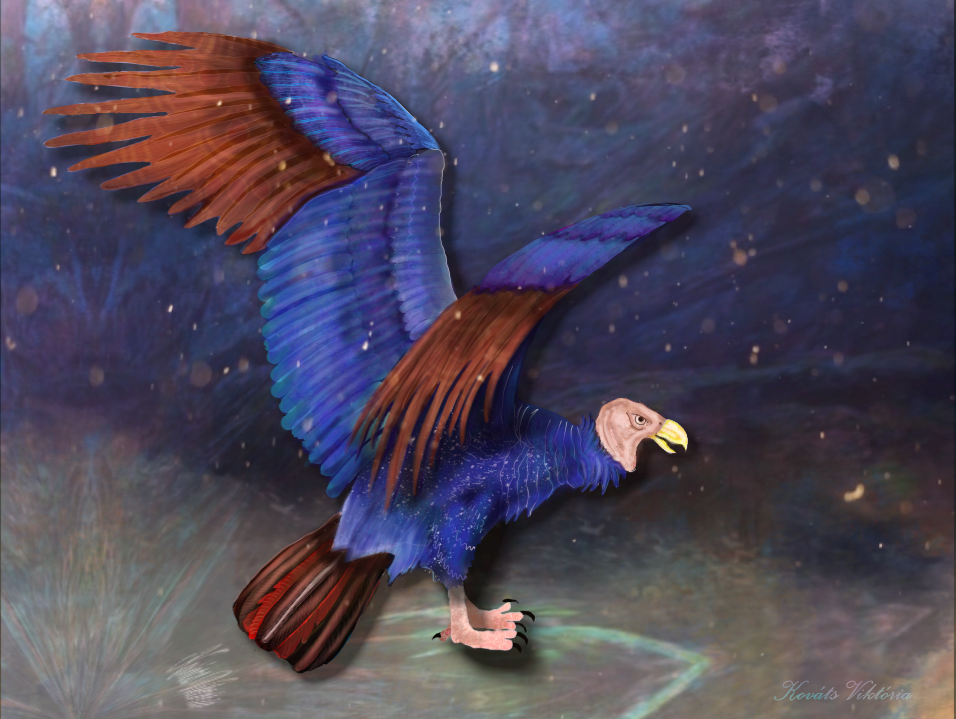
Argentavis magnificens was among the largest flying birds ever to exist. While it is still considered the heaviest flying bird of all time, Argentavis was likely surpassed in wingspan by Pelagornis sandersi which is estimated to have possessed wings some 20% longer than Argentavis and which was described in 2014. A. magnificens, sometimes called the Giant Teratorn, is an extinct species known from three sites in the Epecuén and Andalhualá Formations in central and northwestern Argentina dating to the Late Miocene (Huayquerian), where a good sample of fossils has been obtained.
. . . . . . . . . . . . .
Katya Sviridova Katya Sviridova - "Gastornis"
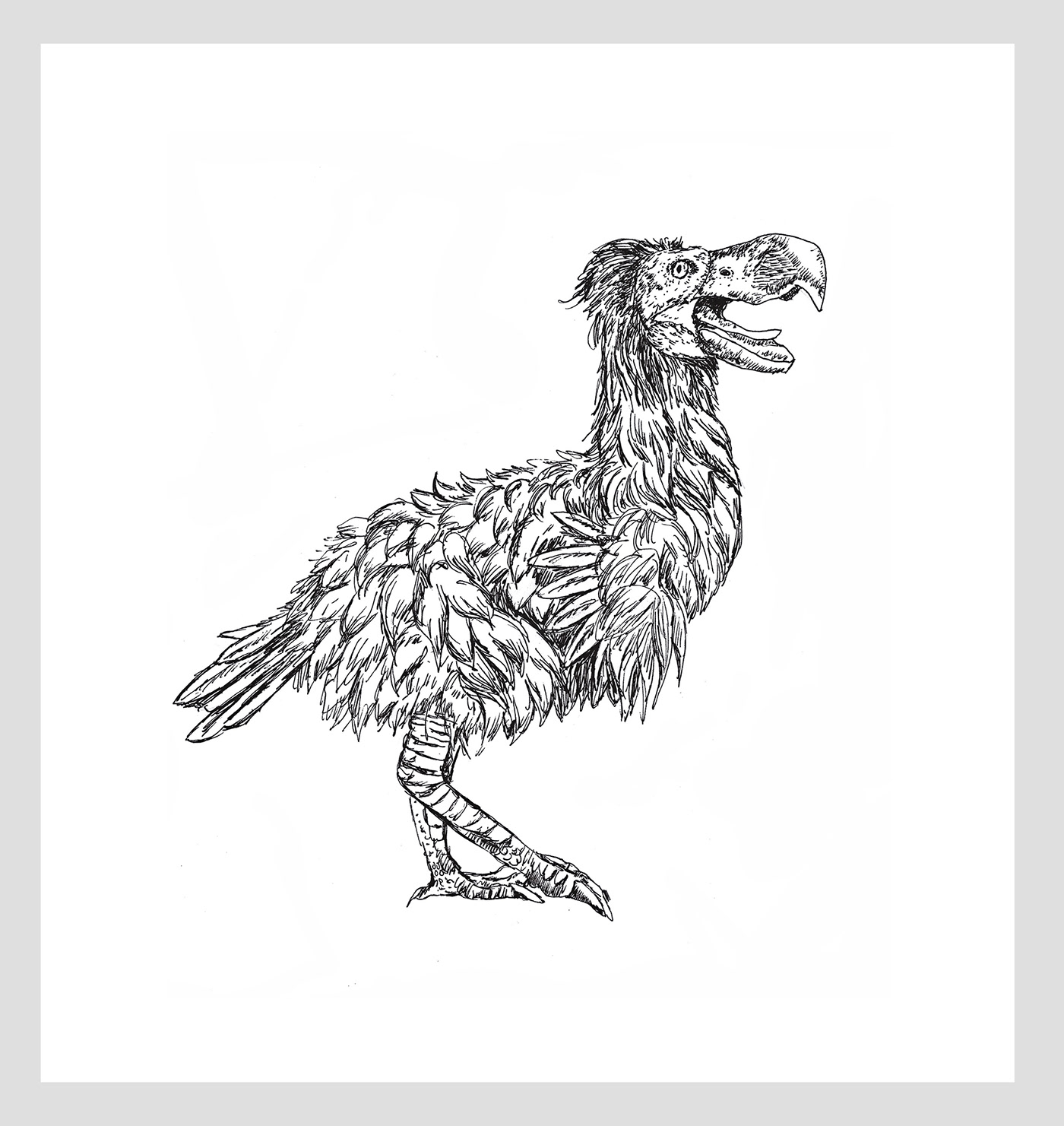
"Gastornis" - a genus of extinct large flightless birds that existed in the late Paleocene and Eocene 56-41 million years ago. Fossil remains were discovered in Europe, and a similar bird belonging to the genus Diatryma lived in North America. Diatrim is now considered to belong to the genus Gastornis. Gastornis reached a height of 1.75 m (diatrim 2 m) and a weight of 100 kg. They had a large beak capable of breaking bones. Therefore, paleontologists used to often suggest that these birds were predators or scavengers. However, recent studies of some details of the bird's structure show that Gastornis was more adapted to consuming plant food. It probably used its beak to dig up edible roots. Gastornis could not fly, but could run well.
. . . . . . . . . . . . .
Katya Sviridova Katya Sviridova - "Archaeopteryx"
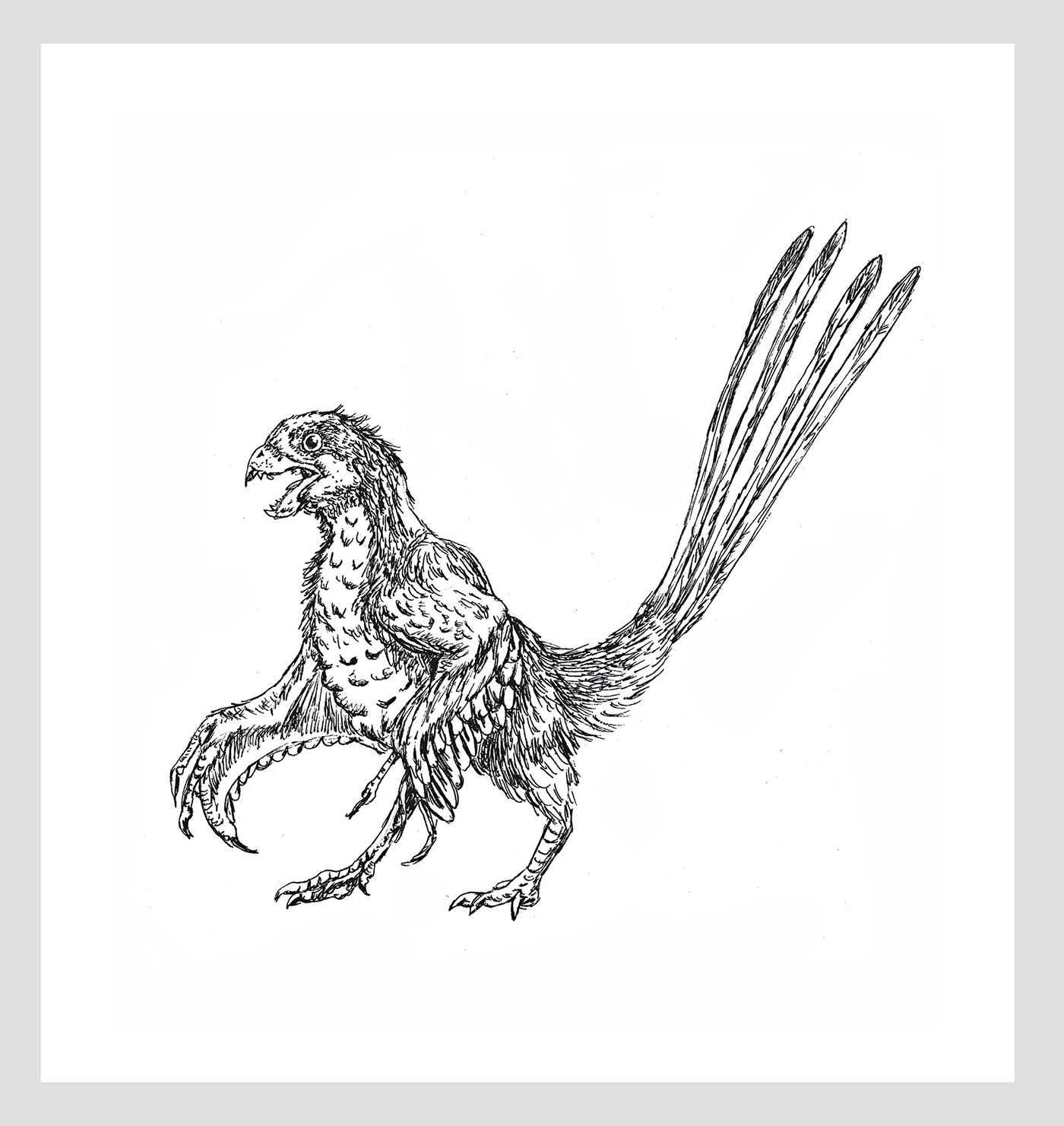
"Archaeopteryx" - the oldest known genus of extinct birds, which belongs to the subclass of lizards (according to another version, it belongs to the side branch of bird-like dinosaurs). There are two species in the genus — Archeopteryx lithographica and Archeopteryx albersdoerferi. It lived in the Jurassic period in a tropical climate, and was roughly the size of a modern crow. The shape of the body, the structure of the limbs and the presence of plumage are similar to modern birds, it may have flown, but in many respects it was close to reptiles. The discovery of Archeopteryx was a brilliant confirmation of evolutionary theory, evidence of the existence of peculiar transitional forms between reptiles and birds.
. . . . . . . . . . . . .
5. Birds and nature.
chiaki suzuki - chiaki suzuki 1. "Azure-winged magpie" - 2. "Varied tit" - Birds and berries
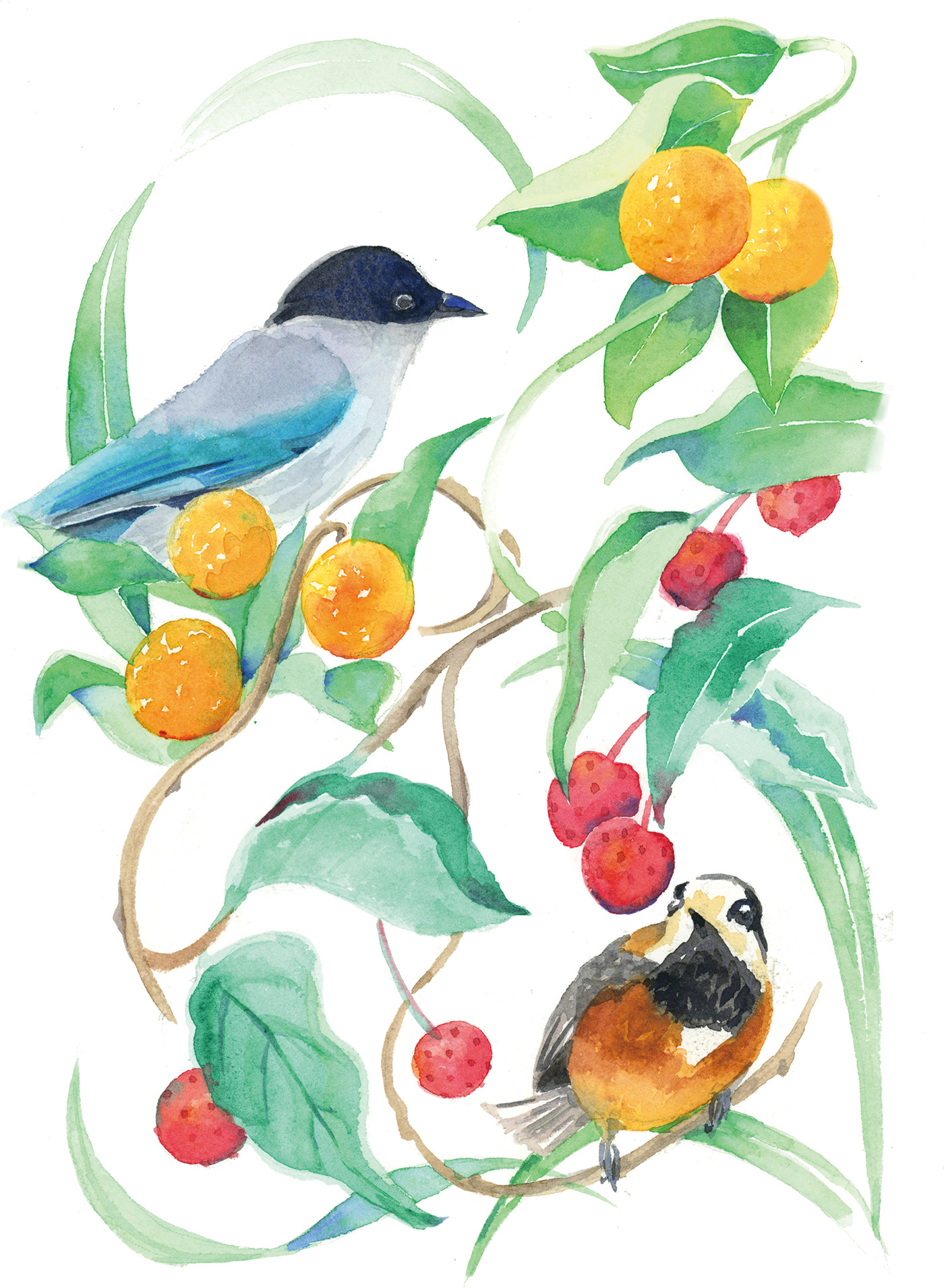
1. "Azure-winged magpie" - This is a bird from the crow family. It is 31–35 cm long and similar in general shape to the Eurasian magpie (Pica pica), but more slender, with proportionately smaller legs and beak. Belongs to the genus Cyanopica. It has a shiny black top on its head and a white throat. The underside and back are light gray-red with wings and feathers of a long (16–20 cm) tail of azure blue. Inhabits various types of coniferous (mainly pine) and deciduous forests, including parks and gardens among the Eastern peoples.
2. "Varied tit" - a species of sparrow-like birds of the titmouse family (Paridae). A small mobile bird, slightly smaller than a sparrow, 12-14 cm long and 16-18 g in weight, with a wingspan of 6.0-7.8 cm. The back, tail and wings are blue-gray. The head and throat are black. The forehead, cheeks and lower side of the body are white with a reddish coating. The sides of the body are bright red. Lives in coniferous and mixed forests. Keeps in pairs and flocks, jumping on bushes and tree branches.
. . . . . . . . . . . . .
Mimi Kraz - Mimi Kraz - "Little blue heron"

The little blue heron (Egretta caerulea) is a small heron of the genus Egretta. It is a small, darkly colored heron with a two-toned bill. Juveniles are entirely white, bearing resemblance to the snowy egret. During the breeding season, adults develop different coloration on the head, legs, and feet.
They have a range that encompasses much of the Americas, from the United States to northern South America. Some populations are migratory. Climate change will probably cause their distribution to spread north. They can be found in both saltwater and freshwater ecosystems. Their preference for either one depends on where they live.
. . . . . . . . . . . . .
Katya Sviridova Katya Sviridova - "Northern hawk-owl"
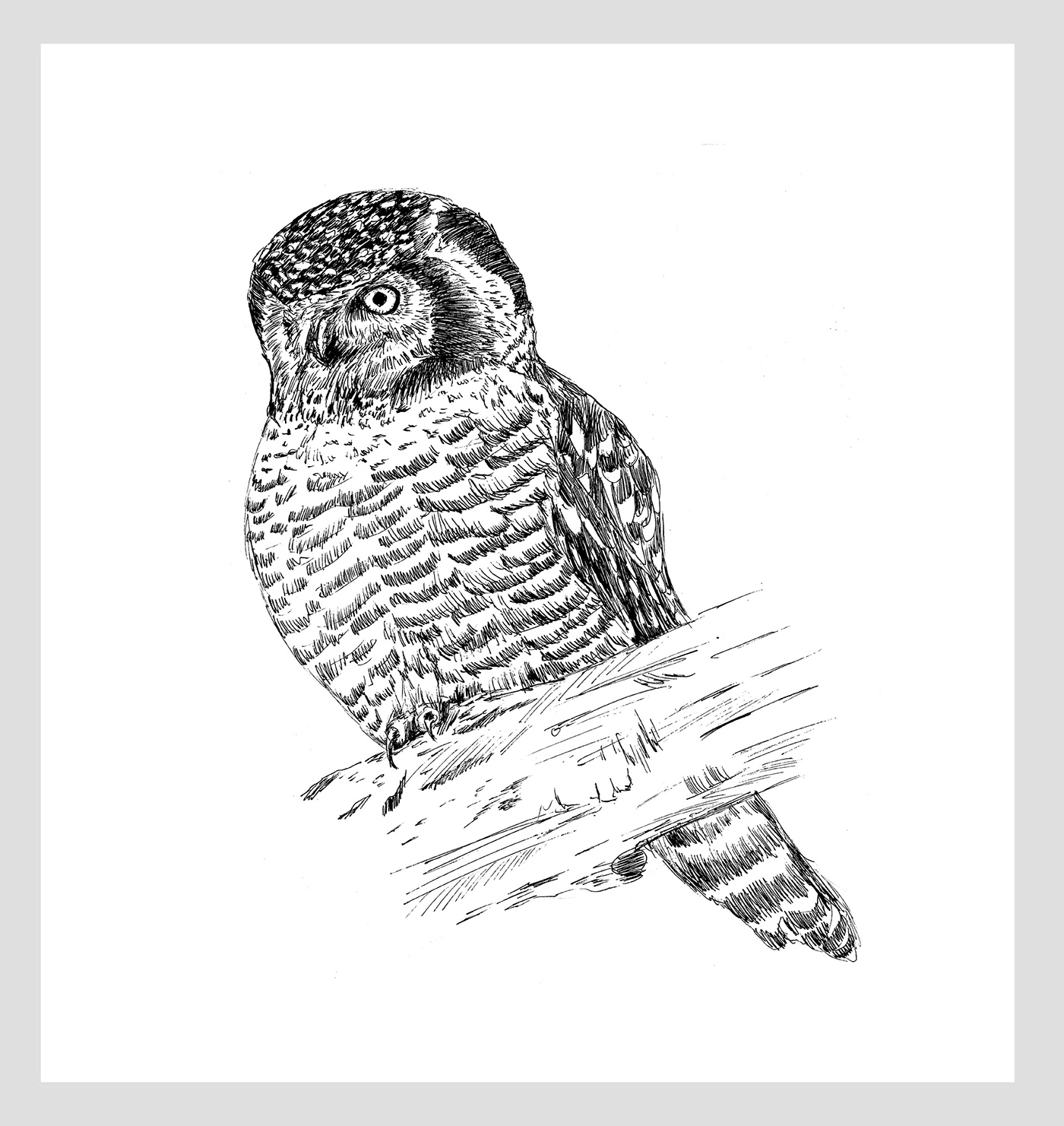
Northern hawk-owl - (Surnia ulula) is a medium-sized real owl of northern latitudes. It is non-migratory and usually stays within its breeding range, although it occasionally breaks south. This is one of the few owls that does not lead a nocturnal or twilight lifestyle, but is active only during the day. It is the only living species of the genus Surnia in the family Strigidae, "typical" owls (as opposed to barn owls, Tytonidae). The species is sometimes referred to simply as the hawk-owl; however, many owl species in the genus Ninox are also referred to as "hawk owls".
. . . . . . . . . . . . .
Debaditya Patra - Debaditya Patra - "Hornbills" (Bucerotidae) - Adobe Illustrator
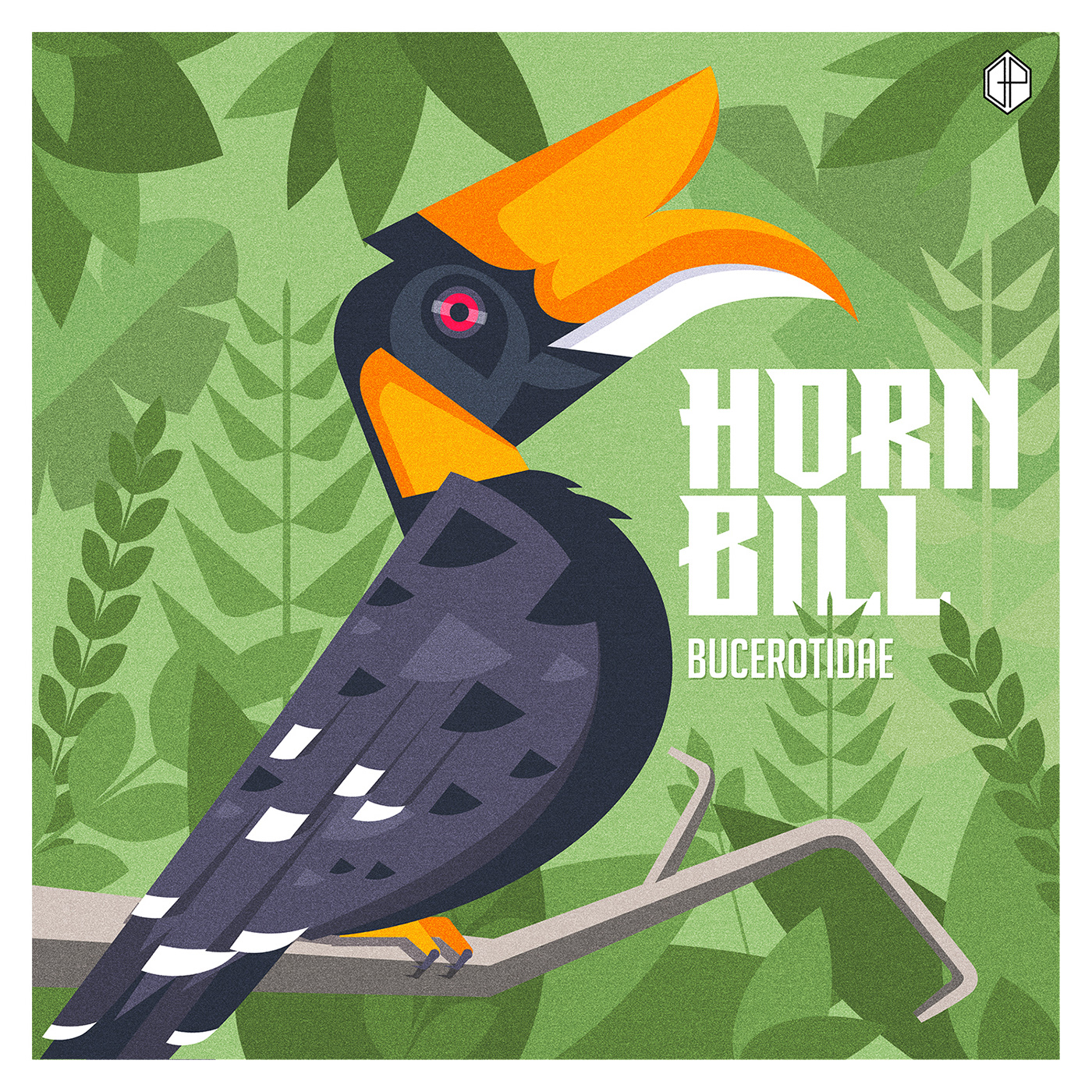
Hornbills (Bucerotidae) are a family of bird found in tropical and subtropical Africa, Asia and Melanesia. They are characterized by a long, down-curved bill which is frequently brightly coloured and sometimes has a casque on the upper mandible. Both the common English and the scientific name of the family refer to the shape of the bill, "buceros" being "cow horn" in Greek. Hornbills have a two-lobed kidney. They are the only birds in which the first and second neck vertebrae (the atlas and axis respectively) are fused together; this probably provides a more stable platform for carrying the bill.
. . . . . . . . . . . . .
Katya Sviridova Katya Sviridova "Laughing owl"
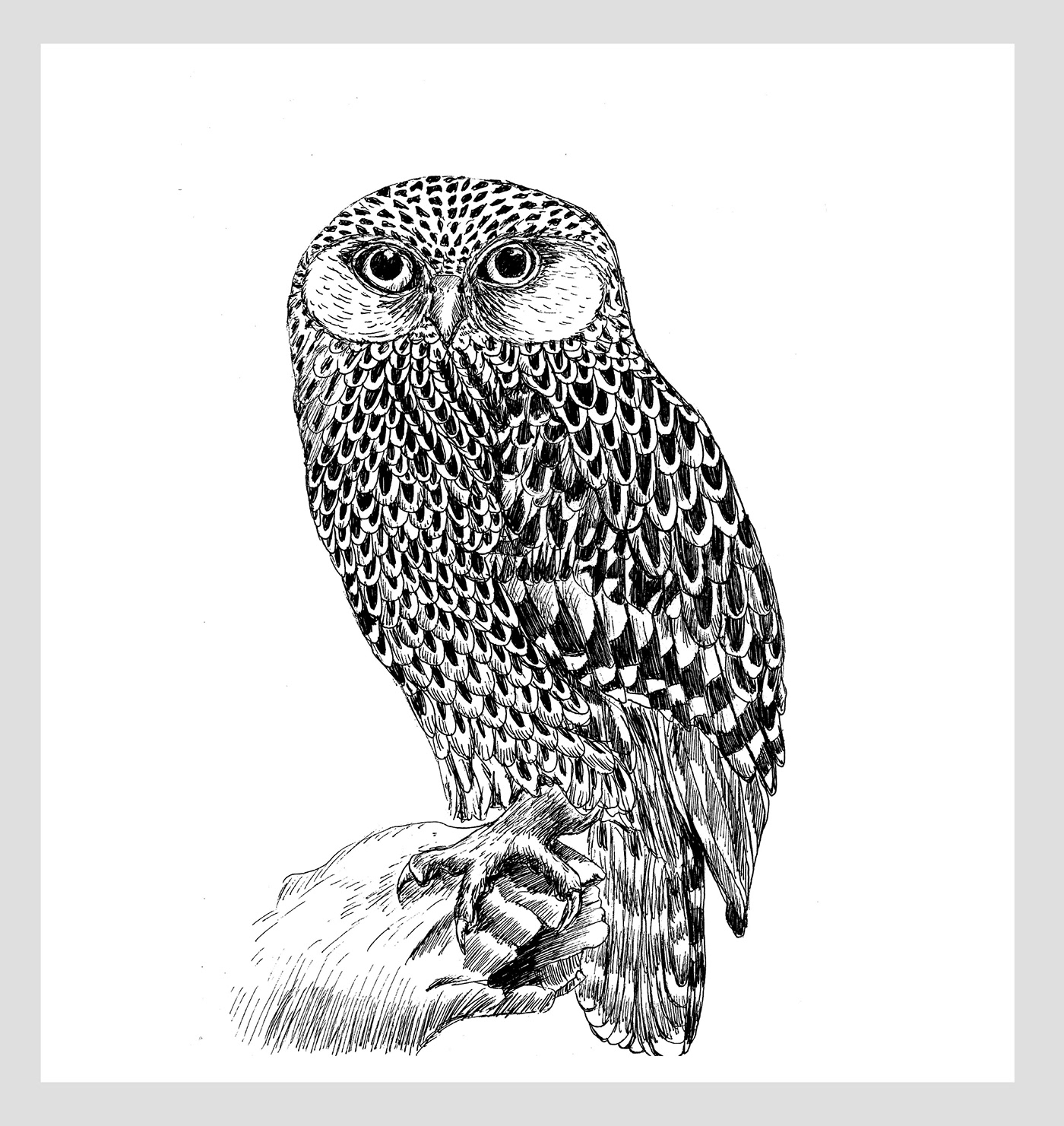
Laughing owl - (Ninox albifacies), also known as whēkau or the white-faced owl, was an endemic owl of New Zealand. Plentiful when European settlers arrived in New Zealand, its scientific description was published in 1845, but it was largely or completely extinct by 1914. The species was traditionally considered to belong to the monotypic genus Sceloglaux Kaup, 1848 ("scoundrel owl", probably because of the mischievous-sounding calls), although recent genetic studies indicate that it belongs with the boobook owls in the genus Ninox. After various studies and analysis it was concluded that it is more of a terrestrial bird due to the great advantage it had to prey on ground at nighttime (1996).
. . . . . . . . . . . . .
Viktória Kováts - Viktória Kováts - "Blue-throated bee-eater"

The blue-throated bee-eater (Merops viridis) is a species of bird in the bee-eater family. They are found throughout southeast Asia in subtropical or tropical mangrove forests. Their diet consists mostly of bees, wasps, and dragonflies. They have a rich variety of songs and calls, including longcalls which allow them to communicate long distances in the forest.
. . . . . . . . . . . . .
Katya Sviridova Katya Sviridova "Blue-and-white flycatcher"
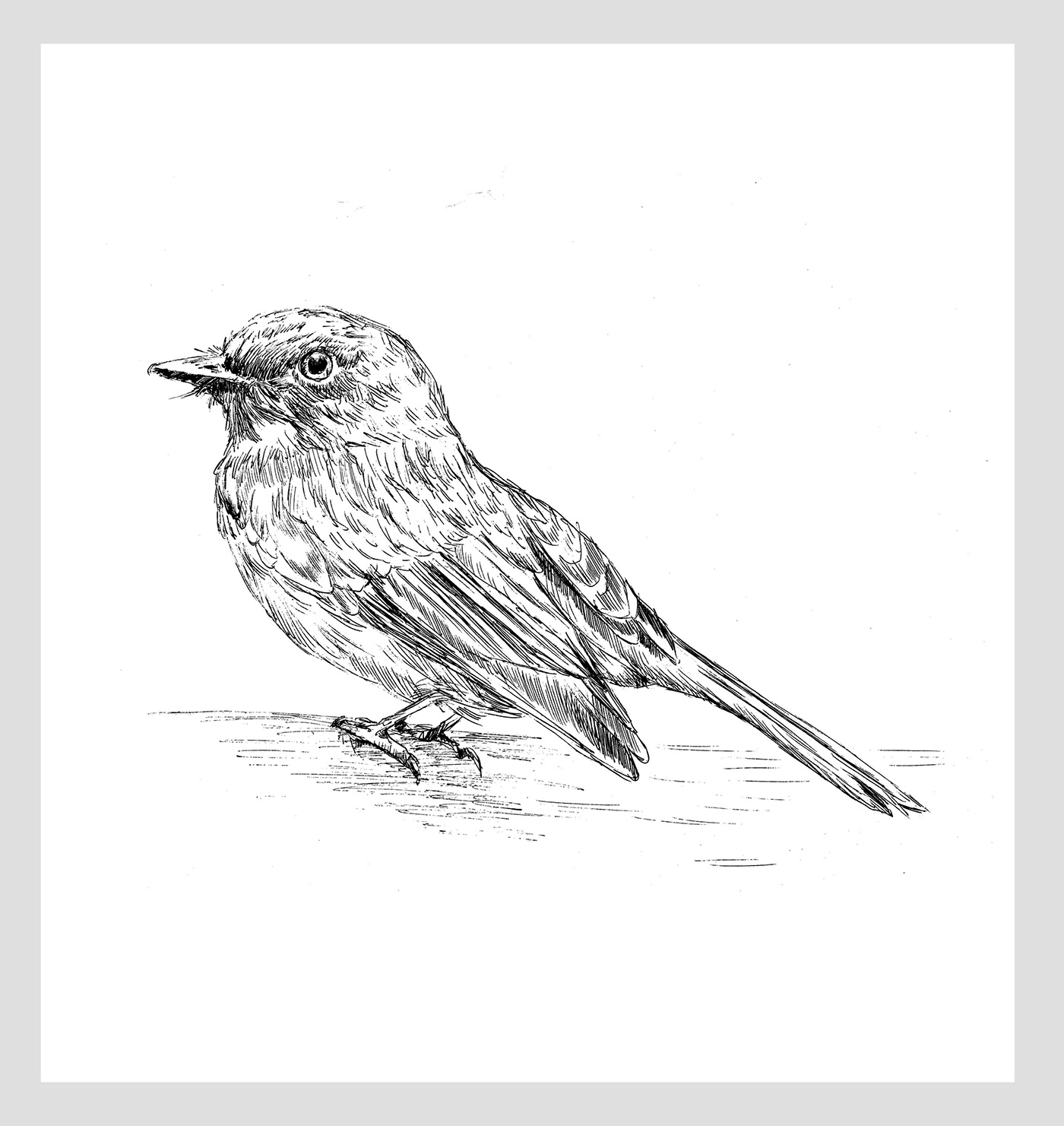
Blue-and-white flycatcher - (Cyanoptila cyanomelana) is a migratory songbird of the Old World flycatcher family Muscicapidae. This species is also known as the Japanese flycatcher. Breeds in Japan, Korea, and parts of northeastern China and the Russian Far East. Winters in Southeast Asia, especially Vietnam, Cambodia, Thailand, Sumatra and Borneo. This species was recorded as a vagrant from the Sinharaja rainforest in Sri Lanka in 2014.
. . . . . . . . . . . . .
Victoria Rice Victoria Rice - "Bullfinch - Rowan berries"
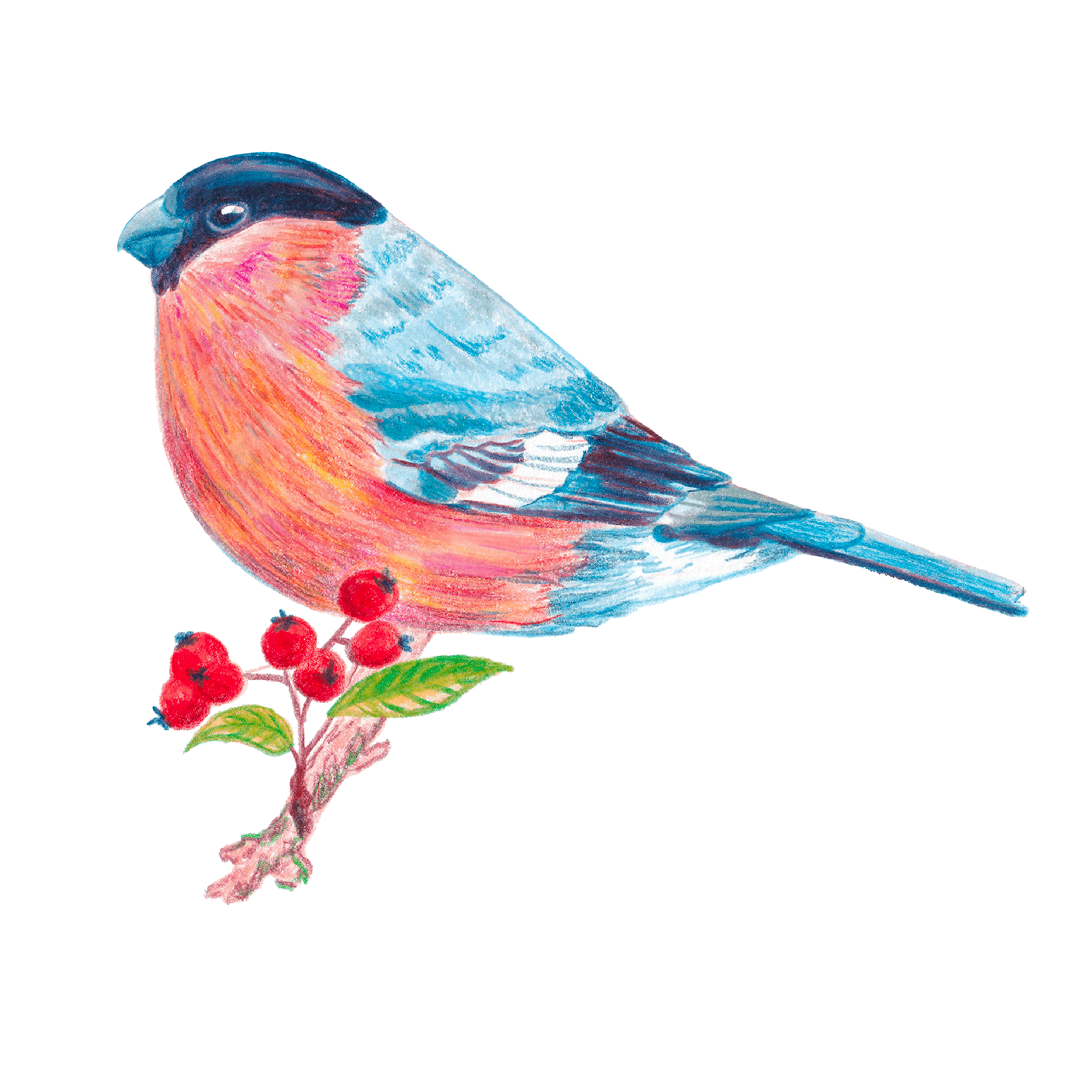
"Bullfinch" - songbird of the bullfinch genus (Pyrrhula), family of finches. Habitat the bullfinch lives in forests with dense undergrowth, it can also be found in the gardens and parks of cities (especially during migrations). In summer, the bird lives both in dense forests and in light forests, but it is rarely possible to notice it. In winter, flocks of bullfinches are very clearly distinguishable, as are individual birds on leafless trees against a snow-white background. In male bullfinches, the breast is pinkish-red, in females it is brownish-gray. The bullfinch feeds on seeds, buds, some arachnids and berries (in particular, mountain ash). Feeding on berries, eats out seeds from them, leaving the pulp. It feeds chicks mainly with plant foods, adding insects and berries. Breeds in coniferous and mixed forests, preferring areas dominated by spruce.
. . . . . . . . . . . . .
Katya Sviridova Katya Sviridova "Glossy ibis" - Plavni - long-term floodplains of rivers and lakes, and deltas covered with thickets of shrubs, reeds, cattails or sedges. Thickets of reeds, cattails, sedges, willows and other plants themselves on floodplains of rivers and lakes and in river deltas.
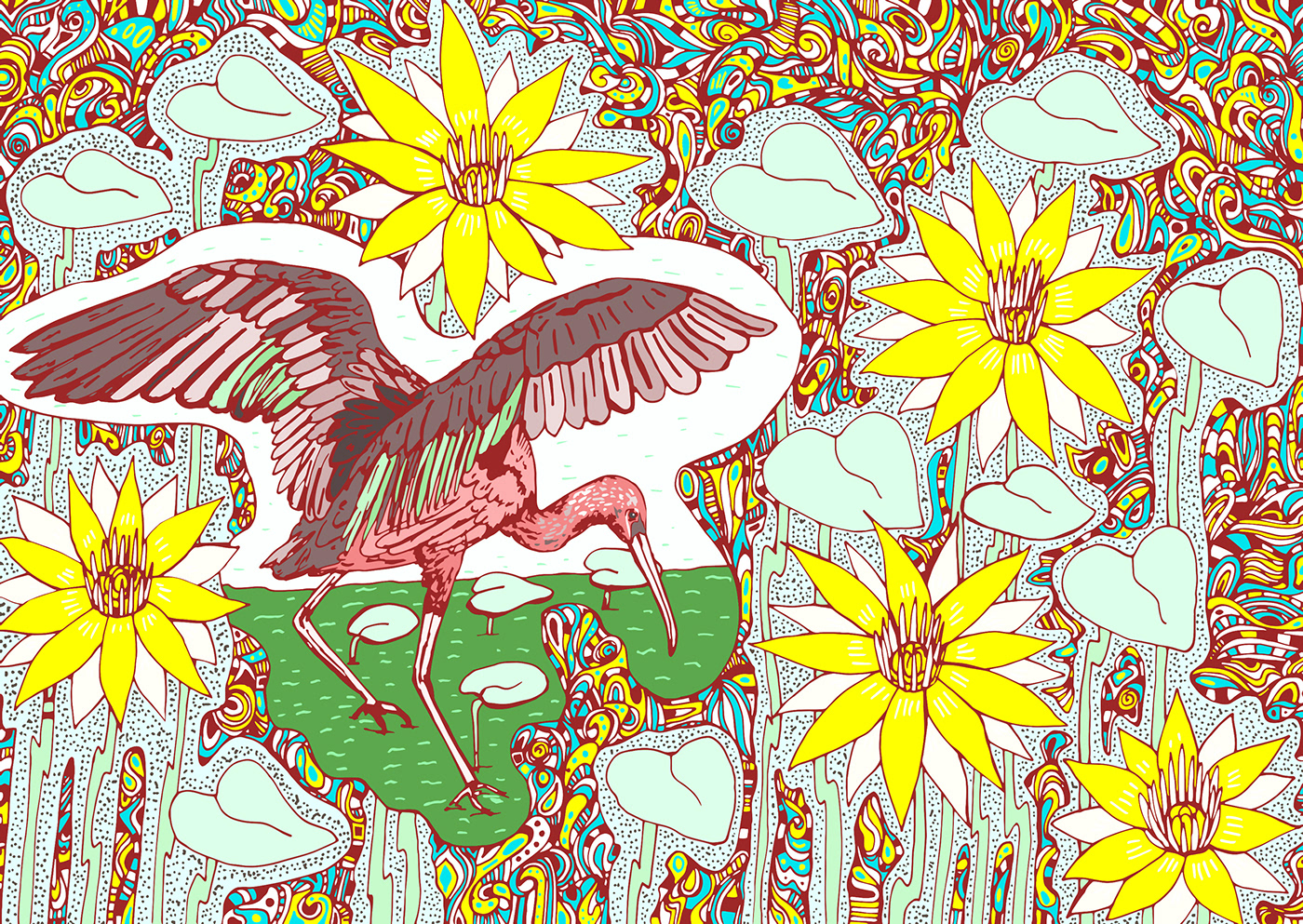
"Glossy ibis" - a widespread bird from the ibis family. Habitats of loaves are fresh and slightly saline water bodies, vast swamps, estuaries, shallow waters and water meadows. They keep in flocks, sometimes up to 100 birds, feed on shallow waters overgrown with reeds with a muddy bottom, sometimes in rice fields, damp meadows. They sleep in the trees. Protection: The species is included in the Convention on the Conservation of Wild Flora and Fauna and Natural Habitats in Europe (Bern, 1979) (Appendix II), the Convention on the Conservation of Migratory Species of Wild Animals (Bonn, 1979) (Appendix II). It is not numerous in Ukraine, it is forbidden to hunt it and it is listed in the Red Book of Ukraine (2009) where it has a nature protection status of vulnerable.
. . . . . . . . . . . . .
ウニ uni - ウニ uni - "Keel-billed toucan" - in the jungle

"Keel-billed toucan" - The body length of the bird is 50-53 cm, weight is 400 grams.
The rainbow toucan has a large, hollow beak that reaches 17 cm in length. The color of the beak is green, with blue patches in the lower part and with an orange stripe on the side. The plumage on the back, belly, and upper part of the wings is black matte, on the upper part of the neck it is black with a red tint. The chest and cheeks are yellow-lemon in color, the lower part of the tail is bright red.
. . . . . . . . . . . . .
Kelsey Wilson Kelsey Wilson "American goldfinch"
Title of Artwork - Gold Finch and Lavender
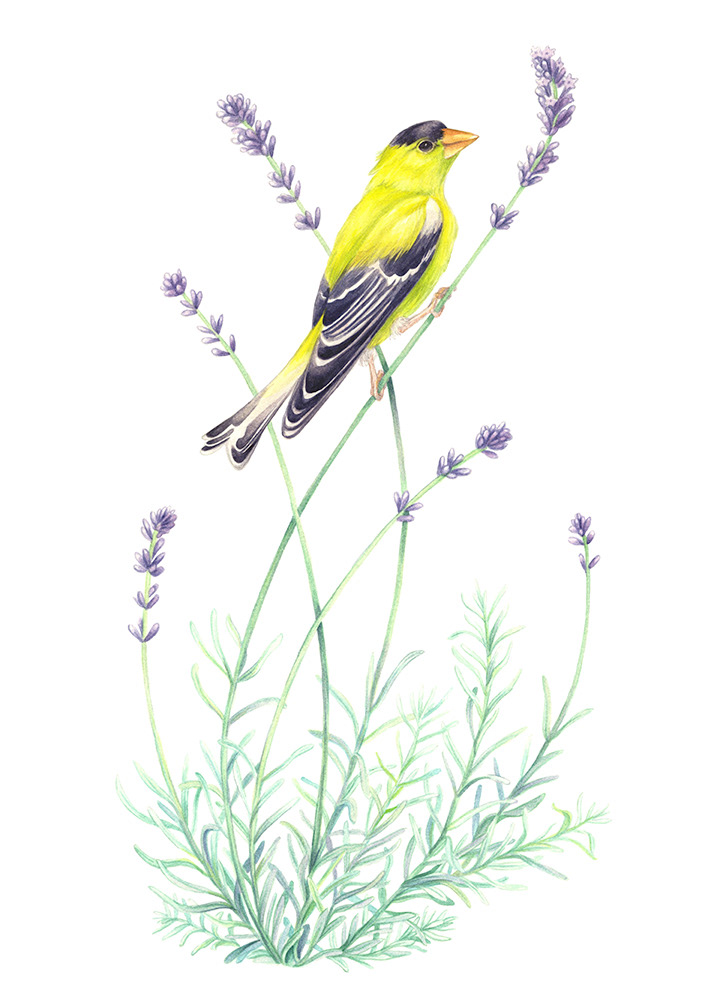
"American goldfinch" - A species of migrating North American passerine birds from the finches family. The birds nest in areas from the Alberta Encirclement to the Northern Bicycle, migrating south for the winter across the Canada Road to the US and Mexico. Birds of this species are the only ones in the subfamily Carduelinae that completely replace summer plumage with winter plumage. Sexual dimorphism of plumage color patterns - males are mostly bright yellow in summer, olive in winter, and females are pale yellow-brown, only lighter in summer. Males perform in a display of their bright plumage during the mating season to attract females.
. . . . . . . . . . . . .
Katya Sviridova Katya Sviridova - "Sri Lanka bay owl" - "Common redpoll"

Sri Lanka bay owl - (Phodilus assimilis) is a species of bay owl in the family Tytonidae. It is endemic to the island of Sri Lanka and the Western Ghats in Kerala, South Western India. It was considered a subspecies of the Oriental bay owl (Phodilus badius) but is now treated as a full species due to its distinctive call, plumage and disjunct distribution.
Its natural habitats are subtropical or tropical moist montane forests and subtropical or tropical high-altitude grassland. It is threatened by habitat loss.
Common redpoll - or mealy redpoll (Acanthis flammea) is a species of bird in the finch family. It breeds somewhat further south than the Arctic redpoll, also in habitats with thickets or shrubs.
. . . . . . . . . . . . .
Viktória Kováts - Viktória Kováts - "Channel-billed toucan"
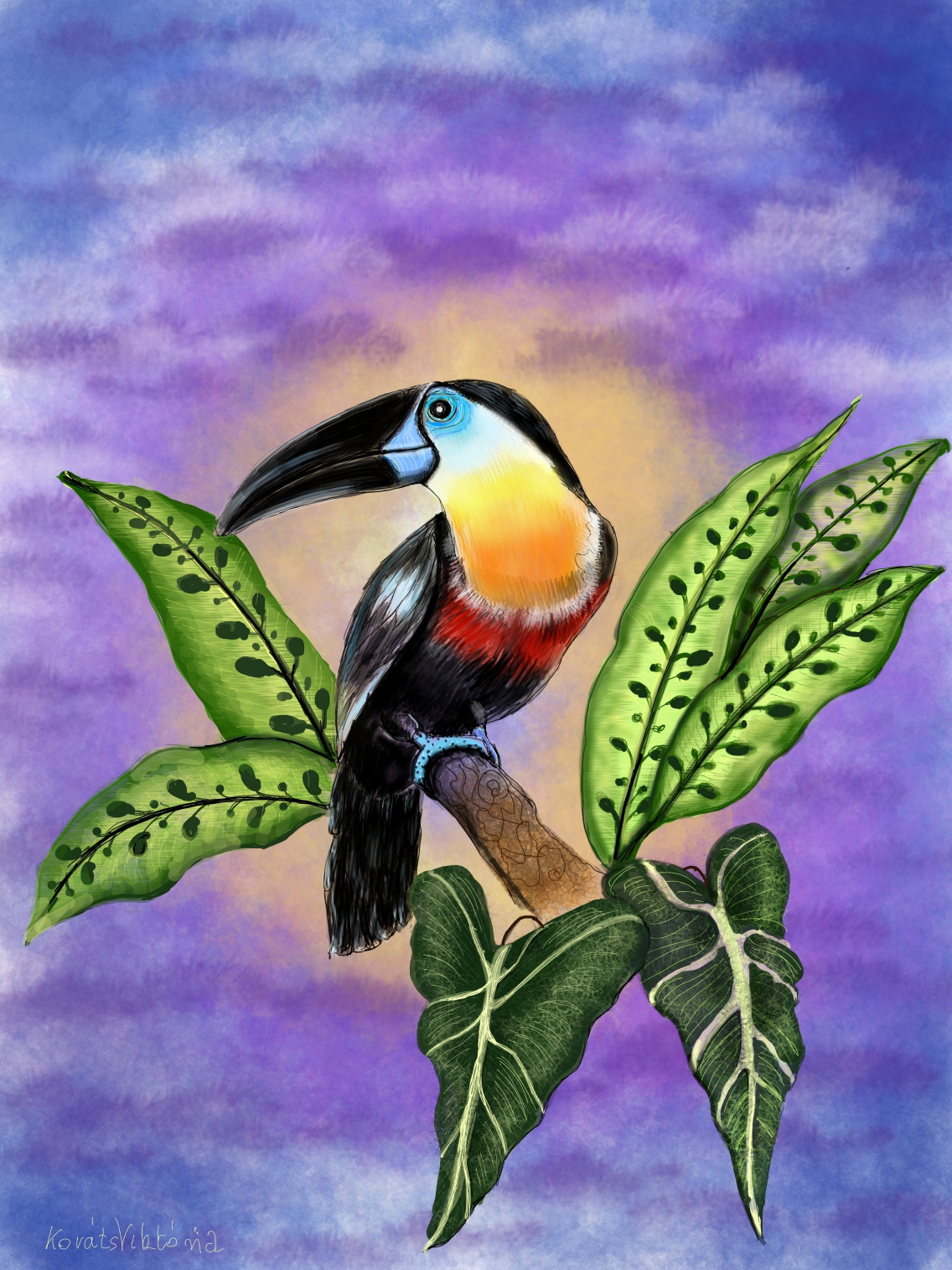
"Channel-billed toucan" - Species of birds from the toucan family (Ramphastidae). Distributed in Trinidad and South America, where the range extends from north to south to southern Brazil and central Bolivia. Bright bird with a large beak. The usual length is 48 cm, beak 9-14 cm, weight 300-430 g. They live in forests. They feed on fruits, insects, small reptiles, eggs and frogs. Both parents were chosen during maturation of the offspring. The eggs are white. The chicks begin to leave the nest after 40-50 days. The protection status is a vulnerable species.
. . . . . . . . . . . . .
Katya Sviridova Katya Sviridova "Rhinoceros hornbill"
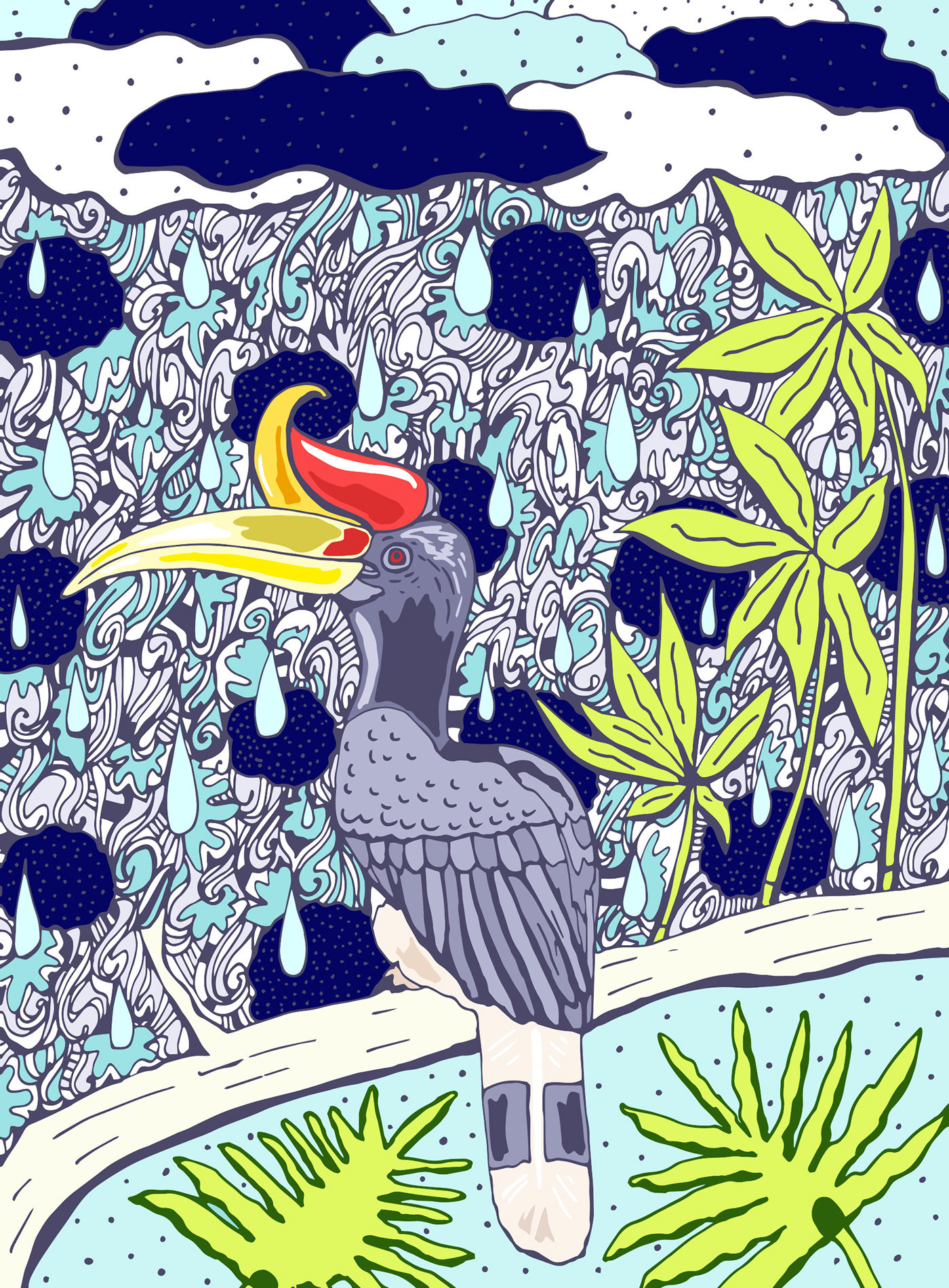
The rhinoceros hornbill (Buceros rhinoceros) is a large species of forest hornbill (Bucerotidae). In captivity it can live for up to 35 years. It is found in lowland and montane, tropical and subtropical climates and in mountain rain forests up to 1,400 metres in Borneo, Sumatra, Java, the Malay Peninsula, Singapore, and southern Thailand, faces a number of threats, including loss of its rainforest habitat, as well as hunting for its meat, and its skull and feathers. Habitat destruction has led to the loss of the large trees the species requires for breeding, which in turn makes it easier for poachers to find the rhinoceros hornbill. It is frequently shot at by poachers due to confusion with the highly sought-after helmeted hornbill. Due to this, the species was uplisted to vulnerable from near threatened on the IUCN Red List in 2018.
. . . . . . . . . . . . .
Paulo Lim - Paulo Lim - "Palawan peacock-pheasant"
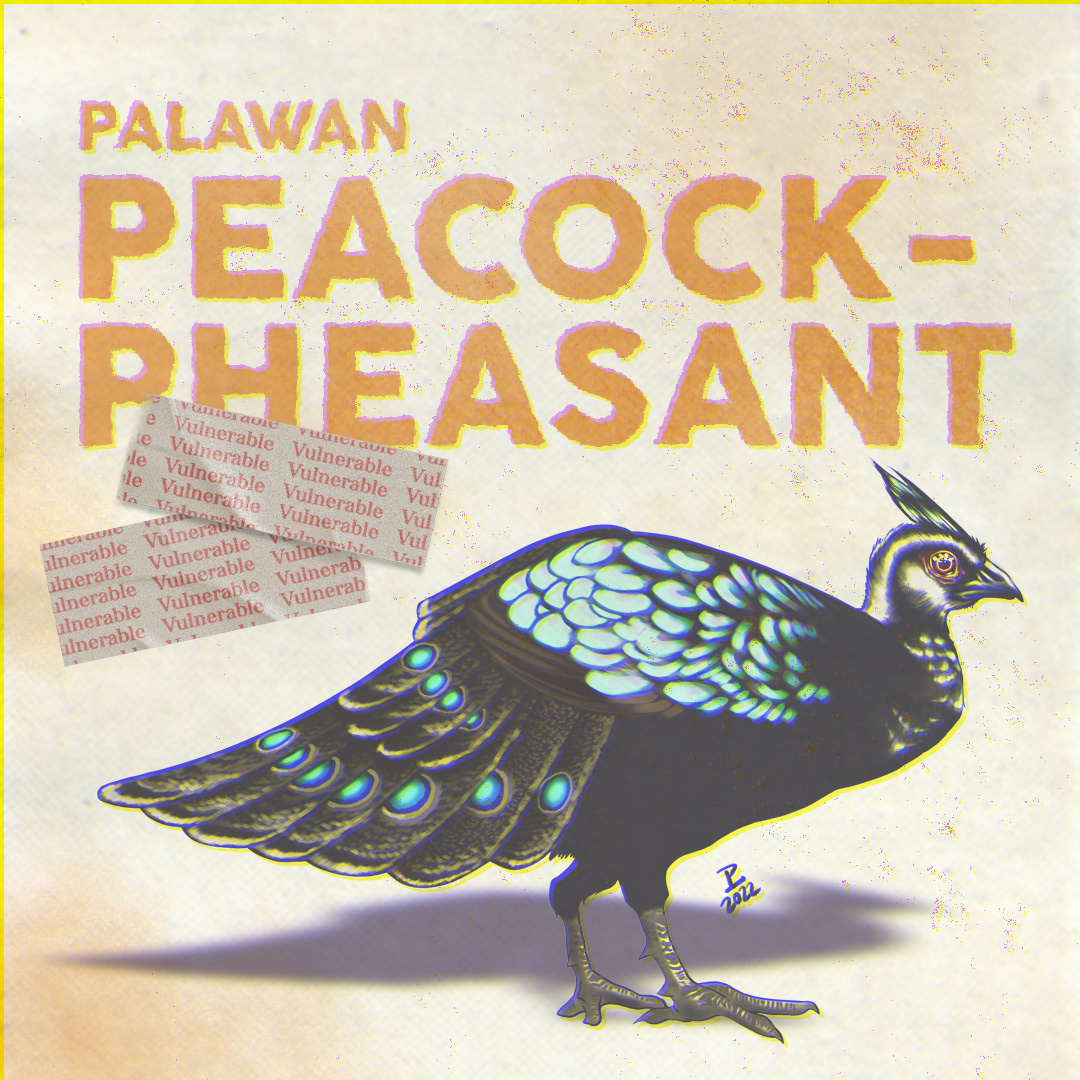
"Palawan peacock-pheasant" - species of birds from the pheasant family of the order Galliformes. Habitat Philippine Islands - conservation status vulnerable species.The total coverage of the Palawan peacock phase in nature is unknown, with rough estimates ranging from 20,000 to 50,000 adults. It is generally accepted that at present this type of supply, and rather quickly, due to large-scale clearing of the lowland forests of the islands and the capture of bird hunting, including for international trade.
. . . . . . . . . . . . .
Katya Sviridova Katya Sviridova - "Richard's pipit" - "Bluethroat"
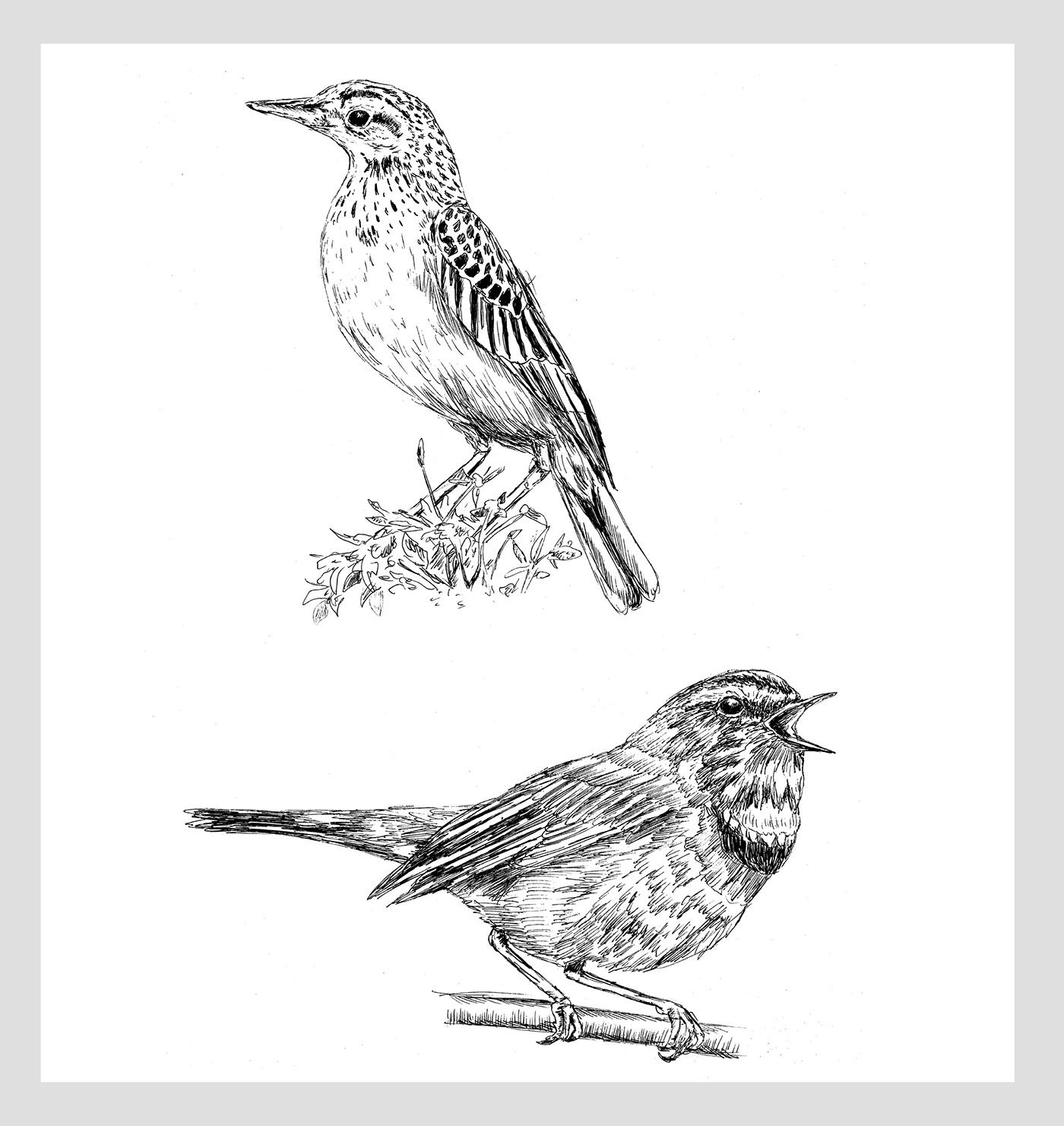
Richard's pipit - (Anthus richardi) is a medium-sized passerine bird which breeds in open grasslands in the East Palearctic. It is a long-distance migrant moving to open lowlands in the Indian subcontinent and Southeast Asia. It is a rare but regular vagrant to western Europe. The genus name Anthus is the Latin name for a small bird of grasslands. The English name and richardi are for the French naturalist Charles Richard (1745–1835), director of postal services at Lunéville and friend of Francois Levaillant.
Bluethroat - (Luscinia svecica) is a small passerine bird that was formerly classed as a member of the thrush family Turdidae, but is now more generally considered to be an Old World flycatcher, Muscicapidae. It, and similar small European species, are often called chats. It is a migratory insectivorous species breeding in wet birch wood or bushy swamp in Europe and across the Palearctic with a foothold in western Alaska. It nests in tussocks or low in dense bushes. It winters in north Africa and the Indian subcontinent.
. . . . . . . . . . . . .
DIGITAL NIBS - DIGITAL NIBS "Motmot"
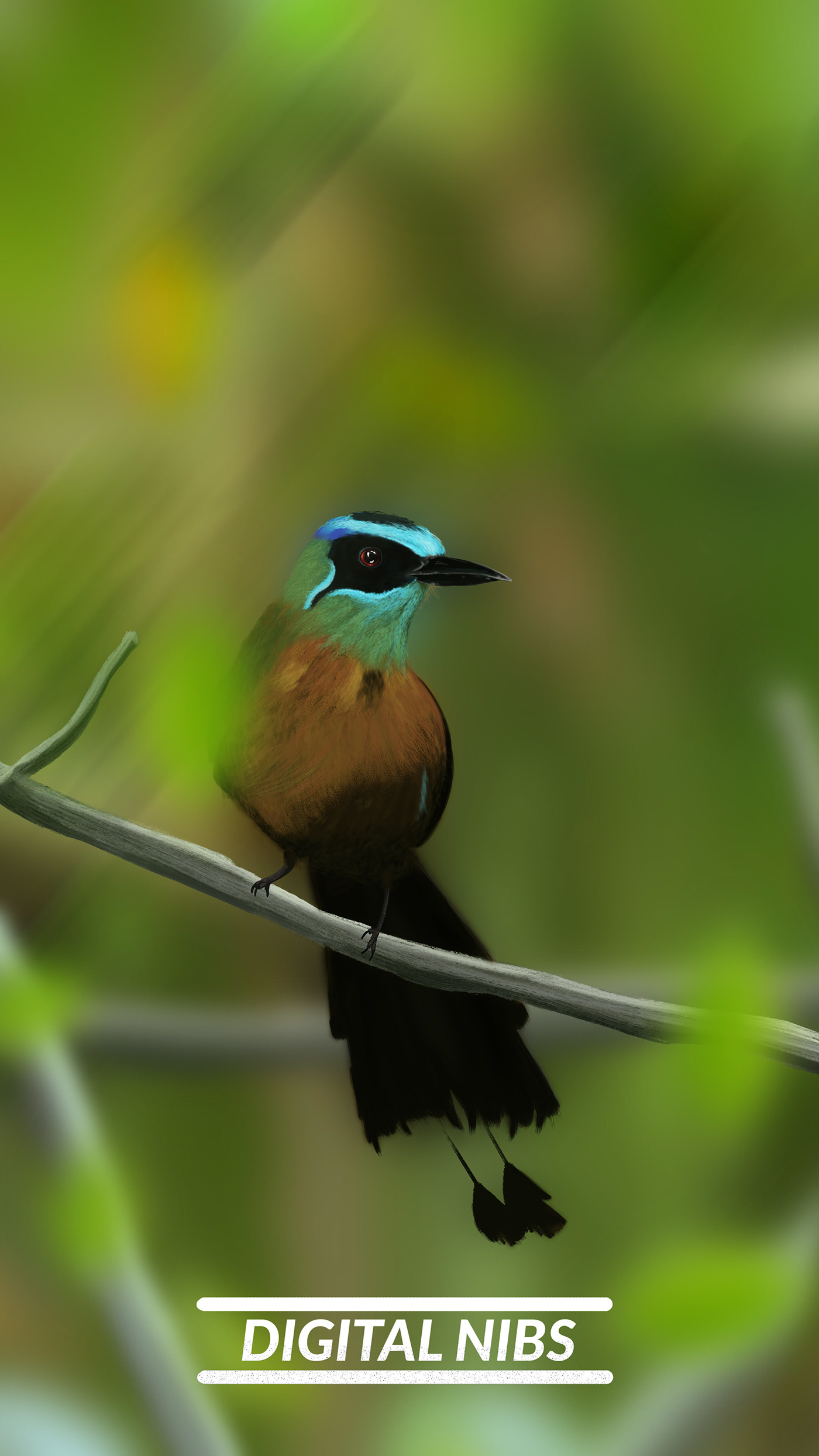
"Motmot" - А family of tropical birds of the order Coraciiformes. Birds of medium size, living in dense selva. Momots are common in Central and South America. Natural habitats are tropical and subtropical forests and woodlands. In addition, birds can also settle close to humans - in gardens and plantations. Representatives of momots can be found in the mountains, at an altitude of up to 3100 m. Most species are sedentary, some make short seasonal migrations.
. . . . . . . . . . . . .
Katya Sviridova Katya Sviridova - "Knobbed hornbill"
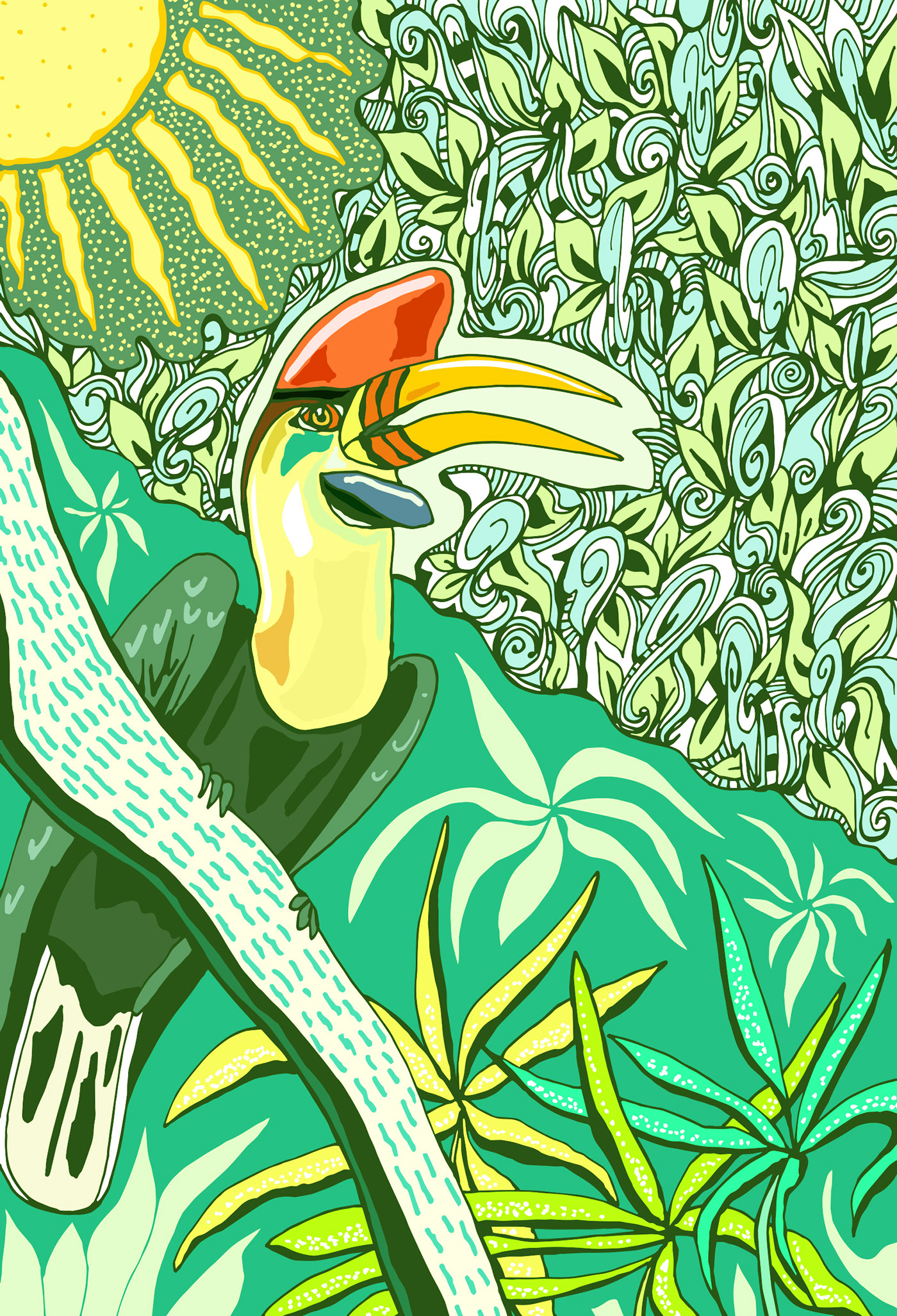
Knobbed hornbill - (Rhyticeros cassidix), also known as Sulawesi wrinkled hornbill, is a colourful hornbill native to Indonesia. The species is sometimes placed in the genus Aceros. The knobbed hornbill is the faunal symbol of South Sulawesi province. The species is currently classified as vulnerable by the IUCN. Despite being locally very common, they are threatened by habitat destruction from logging (since they depend on large and mature trees for breeding) and to some extent by hunting.
. . . . . . . . . . . . .
DIGITAL NIBS - DIGITAL NIBS "Southern cassowary"
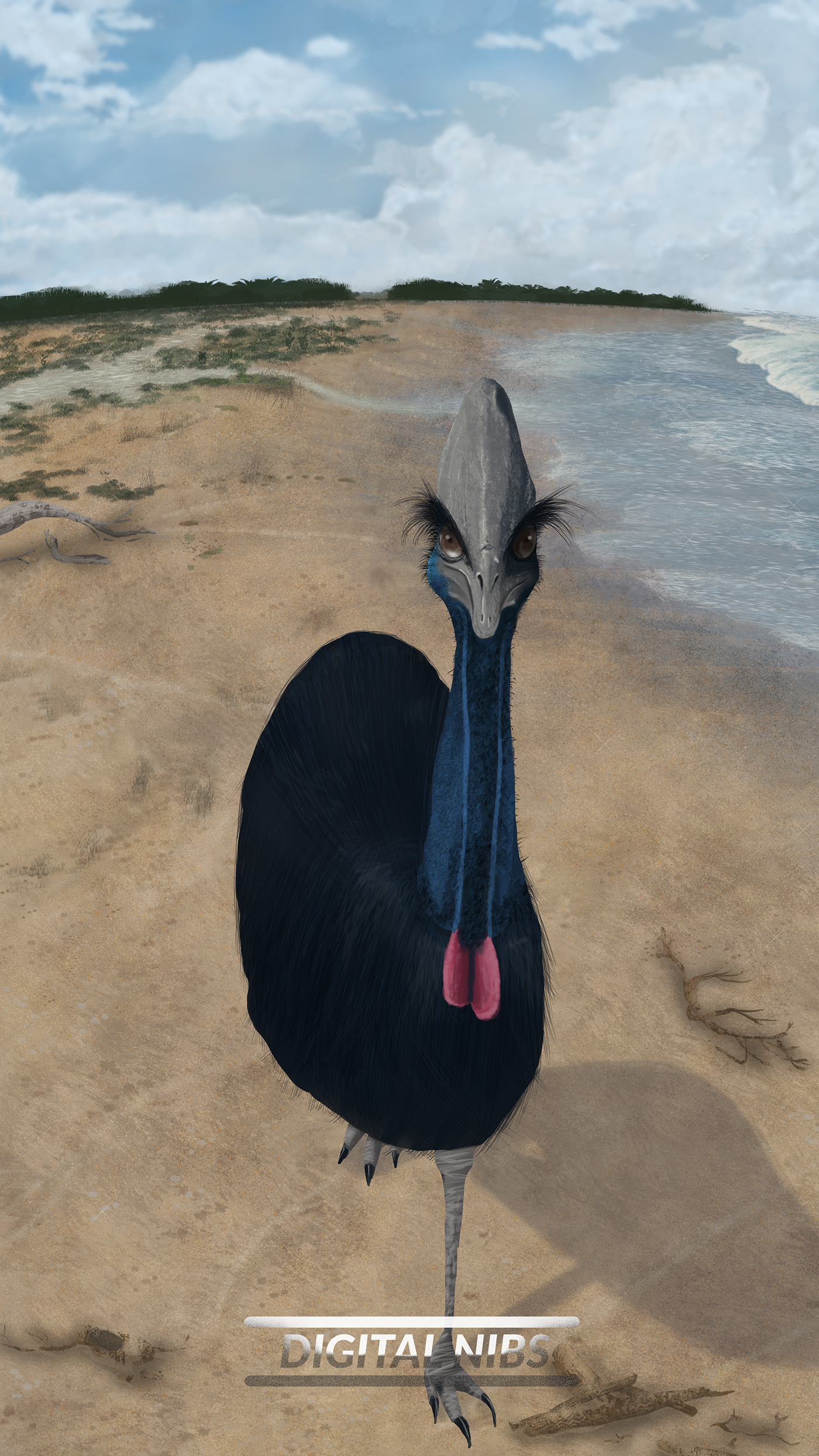
"Southern cassowary"- The massive three-toed legs of this New Guinean bird are armed with large claws, the claw of the inner (first) toe is especially long. With this weapon, the cassowary is capable of inflicting serious wounds, since, defending itself, it inflicts powerful kicks. Cassowaries run fast and jump well. Australia and New Guinea - Conservation status: Vulnerable species.
. . . . . . . . . . . . .
New project of our group 2023
Good afternoon, I want to ask everyone to take part in the new project of our group "Art and Combinations - underwater inhabitants".
To participate, you must create an illustration - on the topic or topic of the project. You can choose any of the 5 themes or all if you like. Also - you can - make an assembly using the theme. The number of illustrations is not limited. Technique and style of freedom, it will also be necessary when sending an illustration to indicate the names of the species, fauna or flora that you have drawn.
The finished work must be sent to e-mail:
The finished work must be sent to e-mail:
----------------------------------------
kat.swiridowa2016@gmail.com
---------------------------------------------
The file can be in JPEG or PNG format. The deadline for citing illustrations is any day before the end of 2023.
Project theme :
Project theme :
1. underwater inhabitants of the seas and oceans; 2. underwater inhabitants of the rivers; 3. underwater inhabitants of lakes; 4. prehistoric underwater fauna; 5. aquarium fauna.
----------------------------------------------------------------------------------------------------------
Оptions for fauna and flora of underwater inhabitants: Fish; sharks; dolphins; whales; manta ; Starfish; Jellyfish; cancer; crab; Lobster; Caridea; Salamander; triton; frogs; toads; aquatic mollusk; sea Horse; Tridacna; coral; seaweed; actinopterygia; osmenog; squid; turtles.
Оptions for fauna and flora of underwater inhabitants: Fish; sharks; dolphins; whales; manta ; Starfish; Jellyfish; cancer; crab; Lobster; Caridea; Salamander; triton; frogs; toads; aquatic mollusk; sea Horse; Tridacna; coral; seaweed; actinopterygia; osmenog; squid; turtles.
. . . . . . . . . . . . .
Thank you very much for participating in the project
. . . . . . . . . . . . .


